Page A3
B3
Page C4


Page A3
B3
Page C4





Tesla inadvertently released over 900 gallons of watertreatment chemicals into a storm drain near Matadero Creek on Oct. 17. is incident prompted cleanup e orts by the city and raised concerns about the company’s environmental record.
According to Palo Alto Online, o cials con rmed that the chemicals were a mix of disodium tetraborate pentahydrate and sodium hydroxide, usually used for stain removal and cosmetics. e chemicals were used to cool Tesla’s
Arti cial Intelligence Supercomputer, which were released into a storm drain that ows to the creek.
While Palo Alto o cials later con rmed the bright green substance wasn’t toxic, Barron Park resident Mike Hedblom, who rst reported the spill while on a walk along Hanover Street, said the incident highlights the need for better response planning by Tesla.
“Accidents are going to happen,” Hedblom said. “It’s a matter of what you do about it … Tesla wasn’t prepared for this, but hopefully they’ll handle it better next time.”
Tesla representatives did not respond to interview requests from e Campanile.
In addition to what Hedblom said was poor disaster management, junior Talia Boneh said she was worried about the environmental and health implications of the spill.
“If the chemical was toxic, it could have been really dangerous for a lot of Palo Alto residents,” Boneh said. “Seeing the neon green in the news was obviously really startling and shocking, so I’m relieved to know that it was not harmful.”
916 gallons of chemicals leaked into Matadero Creek on Oct. 17
Other residents were also unhappy with the poor communication from the city. Barron Park Neighborhood Association president John King said he did not learn about the spill until a week later when a neighbor sent him an article from Palo Alto Online.
“He sent me the message about this incident and I said, ‘Wow, I’m really surprised that it’s been nearly a week, and I’m nding out through a neighbor, and there wasn’t any noti cation,’” King said. “I should be one of the rst people that should be contacted by city o cials.”
And senior Alma Bendavid said the city should have done more to inform residents about the spill. “ e city should have been a lot more transparent about the spill, because whether the chemicals are harmful or not, it's a scary experience for anyone who might see it,” Bendavid said. “It's crazy the way that stu like this doesn't get publicized very much.” City of Palo Alto O cials did not respond to interview requests from e Campanile. King also said the lack of communication from the city has left the Barron Park neighborhood feeling vulnerable.
“ e Barron Park neighborhood is su ering from some PTSD,” King said. “Just let us know. We should have a more direct line of information that comes to us in a timely manner because ultimately, we want to nd out what happened, when it happened, and make sure that there are solutions so it doesn’t happen again.”
Meryem Orazova & Shaurya ummalapalli Sta Writer & Guest Writer
In an e ort to address what supporters say are inequalities in college admissions, Gov. Gavin Newsom signed Assembly Bill 1780, banning legacy and donor preferences in private college admissions across California. e law goes into e ect in 2026. California joins four other states who have similar measures aimed at increasing diversity and reducing systemic advantages for applicants with family connections to selective institutions.
But former Princeton University admissions o cer Hope Murtaugh isn’t so sure the bill will do what its supporters say it will. Murtaugh said while legacy status often provides an extra boost to alreadystrong applicants, it is not a decisive factor on its own.
“Legacy de nitely tips people who were already quali ed,” Murtaugh said. “It might be one of those things that makes somebody stand out, but it never
lets people get in by itself — never. It’s too competitive for that.” Murtaugh also said she doesn't think the policy will increase socioeconomic diversity because most legacy admits are already well-quali ed.
“ e policy is going to weed out maybe half of the legacy admits,” Murtaugh said. “ ose seats would just go to the general applicant pool, and they aren’t going to be limited to lower-income or rst-generation students.”
Junior Bela Patel-Meyers, whose mother went to Stanford for her undergraduate degree, said her status as a Stanford legacy has had little in uence on her college plans.
“Having a legacy tie doesn't really make me want to apply there,” Patel-Meyers said. “Honestly, hearing about Stanford from my mom and her sisters, who both work there, doesn’t make me want to apply either.”
However, a junior with legacy connections to Stanford and who requested anonymity because of potential back-
lash from admissions o cials who might read this story, said they were only going to apply to the university if they had the edge their parents’ and sibling’s connections provided under the current policy.
“ e experience of going to Stanford would be very similar to Paly because they are literally right next to each other,” the junior said. “If I didn’t have legacy there, I wouldn’t ever weigh Stanford as a choice.”
One way that Murtaugh said she sees California's law making a potential di erence nationwide is that it may inspire more states to initiate bans against legacy admissions. Several states, including Massachusetts, have such bills pending in their state legislatures. ere are four states that already have restrictions, and I could see it spreading further,” Murtaugh said. “If uber-selective colleges are already denying the majority of alumni children, and it hasn’t hurt their fundraising, then what’s the argument for keeping it?"
Meryem Orazova Sta Writer
After winning all seven battleground states, Donald Trump was elected as the 47th president of the United States. e Republicans also gained control of the U.S. Senate and the House of Representatives.
is election marks the rst time a Republican presidential candidate has won the popular vote since 2004.
Trump is also the second president, after Grover Cleveland in 1889 and 1897, to serve non-consecutive terms.
U.S. Government and U.S. History teacher Stephen Foug said he was surprised by the outcome of the landslide election given multiple polls predicted a tight race.
“He’s winning over people in big cities that have been Democratic playgrounds for decades,” Foug said. “Focusing on identity might be a losing strategy in terms of winning votes because one strategist was saying last night that it seems to be coalescing around class and money.”
Junior Tarika Pillay, who generally supports the Democratic party, also thought the outcome was surprising.
“I wasn’t expecting Trump to win by the margin that he won,” Pillay said. “I thought for sure (Harris) was going to have a really strong hold or she was going to really ght for her ground. But as I was watching the election, and I was looking at all the stats, I knew that no matter how much we hoped she would pull through, at the end of the day, Trump was going to win.” decision to drop out of the race and give his support to Harris may have also led to their loss.
e Democrats seem to be disconnected and can’t didate from all that enthusiasm that was happening over the summer,” Foug said. “Republicans are just being led around by an individual. I like the idea of the e the House, Senate and the presidency, (but) you need that adversarial system to force the best ideas to the surface and get compromised.”
Foug also said he was puzzled by voter turnout in this election, particularly in light of the extensive discussions about it on social media.
According to the Washington Post, although this year’s turnout was the second highest of the past century, it still fell short of the record set in 2020.

“Voter turnout means everything, win or lose,” Foug said. “I’m not sure if he got any more total votes than last time. I wonder how much ected this, which is weird to me be cause I feel like this
more youth voices may have helped the Democratic party, but that many are not old enough to vote.
tant to take into account this new generation, and I think a majority of us did vote for Harris, but, obvi ously — people in the working class — there’s so many more of them,” Pillay said. “ ere were more people who were screwed over by Biden, unfortunately, who were rooting for Trump this time, so Gen Z was just overridden.”
Peter Colombo, whose most recent teaching position in the district was at Greene Middle School as a physical education teacher, sued Palo Alto Uni ed School District in February for defamation, false imprisonment and lack of due process.
Colombo was charged in 2022 with sexual assault of a child after a former student’s husband alleged Colombo sexually assaulted his wife in 2001 when she was in sixth grade. Colombo was subsequently put on unpaid leave by the district.
However, in April 2023 the Santa Clara County district attorney’s o ce dropped the charges citing lack of evidence to proceed.
Colombo’s attorney, Evan Nelson, said Colombo is currently employed in the district, but not as a teacher.
ey have him stuck in the district o ce with a made-up position,” Nelson said. “ ey’re having him do stu like watch sand deliveries and move goalposts that got left out on the soccer elds and things like that. at’s not what he got his certi cate for.” Nelson said when the sexual assault accusation was made in 2022, it came to Colombo’s wife and the school district before Colombo reported it to the police on his own initiative.
“ e accuser’s husband sent an email not just to the district, but he sent an email to Pete’s wife,” Nelson said. “Pete was the rst one to report it himself. He’s a mandatory reporter.”
Due to the severity of the crime, Nelson said the district was supposed to investigate the allegations but never did.
Superintendent Don Austin and Board of Education
President Jennifer DiBrienza both declined interview requests for this story.
“With Title IX, they’re supposed to investigate something that involves this kind of a serious allegation that could have an impact on the safety of current

changes our world, and Trump makes it impossible for us to live, we’re not going to feel really positive about politics. We’re not going to think about it as a good thing. We’re not going to think about it as a way to change the world. We’re going to think about it as a big enemy that we need to get rid of.”
Regardless of the outcome, Foug said he is interested in seeing how the two political parties evolve after this election.
“What this Democratic Party stands for, what this Republican Party stands for — those are two interesting shifts that we’re going to see, maybe as a result of this election,” Foug said. “We’re right in the middle of that shift right now … Democrats seem to be accounting for a di erent group than they did four, eight, 40 years ago. Same with Republicans.”
One potential evolution that has Pillay concerned is how Trump’s policies will shape the country’s future.
students,” Nelson said. “ ey didn’t do any of that. ey put him on leave six months later, in about June of 2022. at’s when the (Santa Clara) district attorney decided to arrest Pete based on information that the detectives had found.”
But in an interview with e Paly Voice in May of 2023, after Colombo’s charges were dropped, Austin said the district planned to conduct its own investigation into Colombo’s conduct.
“We have di erent standards than the legal system when it comes to what we need to look at,” Austin said in the interview.
According to Nelson, though, around the time when Colombo was arrested, the police only talked to one of the four female P.E. teachers at Greene during the investigation and the other three had information that would have exonerated Colombo.
e Palo Alto Police Department initially agreed to an interview request but did not respond to subsequent questions.
In her court declaration, thenGreene P.E. teacher Aimee Becker said the alleged crime could not have occurred as described given that she had been present the entire time.
“I can, and do, unequivocally testify that what the accuser reported to have happened as a rape/sexual assault during that year is 100% utter nonsense,” Becker testi ed. “It absolutely could not have occurred, and I testify that it did not occur based on my own personal knowledge being present and in charge of the girls’ locker room at that time.”
Nelson also said an immediate Title IX investigation carried out by the district, which he said didn’t happen in this instance, would have helped exonerate Colombo earlier.
“I appreciate it’s a di cult situation, rst, for districts of schools to deal with these kinds of allegations,” Nelson said. “ at’s why the timeline is there. It’s not
She also said this election helped her realize how important her future vote will be.
“While I was watching the election, it really occurred (to me) that literally every vote counts,” Pillay said. “(Being) based in the big states that have the big votes, if you make a di erence in that, you make a di erence in the whole election.”
Annika Chu News/Opinion Editor
just to protect the accuser — it also protects the accused, and so there’s due process there that needs to be followed to make sure that everybody’s adequately protected.”
And while Nelson said some might consider no immediate Title IX investigation a good thing for someone like Colombo accused of a crime, Nelson said this is not the case.
“Isn’t he glad they didn’t do a Title IX investigation?” Nelson said. “Well, no. Title IX has a bunch of due process in there for both the accuser and accused, and it’s very important to make sure that both sides get those protections.”
As a result of the way he alleges the district has treated Colombo, the lawsuit against the district names Austin, Trent Bahadursingh, Lisa Hickey and Amanda Bark as co-defendants.
Bahadursingh is the deputy superintendent and Austin’s chief of sta while Hickey is currently the superintendent of Millbrae Elementary School District but was PAUSD’s director of human resources for certi cated personnel at the time Colombo was placed on leave. Bark is the district manager of policy and legal compliance.
Bahadursingh, Hickey, and Bark all declined interview requests for this story.
Nelson also said one of the most complicated parts of the case has been that the district hasn’t been able to produce the accuser’s grade reports and attendance records.
“ e grade report would have said who her PE teacher was and how could that be deleted and gone missing?” Nelson said. “And to this day, it has not been produced, and there’s been no adequate explanation for what happened to it.”
According to the PAUSD website, “Records are maintained for students who attended PAUSD schools from the early 1900s to the present.”
Junior Sahil Srivastava, who had Colombo as a P.E. teacher at Greene, said he was appalled when he rst heard about the charges against Colombo.
“I was really surprised,” Srivastava said. “Obviously, there’s a lot of things that were unknown, and later, I believe the school district posted a message about it
where all the facts came out, and I think it was really disturbing to hear.”
However, incoming school board trustee and #MeToo activist Rowena Chiu said while it may not apply to this case, false sexual assault allegations are quite rare.
“Now, I would say broadly — this isn’t a comment on Peter Colombo’s innocence or guilt per se — but, and I want to be careful, I stress that ‘but,’ I would say broadly, it is very di cult to come forward with the sexual assault accusation,” Chiu said.
Chiu also said in cases like these, it is important to err on the side of caution.
“In my personal opinion, I think, for the district, the safest precaution would be not to allow a teacher accused of sexual assault to return to teaching until there is a legal case that has proven beyond reasonable doubt that they have not committed a sexual assault,” Chiu said. “But in this case, this is very complicated because the charges were dropped.”
Srivastava said, despite the charges being dropped, he thinks Colombo should not return to teach at the district.
“Honestly, I feel that he shouldn’t return, because, yes, the case was 20 years old, and it is hard to gather evidence from so long ago, but any allegations like that are deeply disturbing, especially for a teacher who’s job is to work with kids,” Srivastava said.
However, Nelson said Colombo should be given back his previous teaching position.
“When you’re put on an involuntary or a forced leave, they need to retain your position for you when you come back, and the district didn’t do that,” Nelson said. “And even right now, I mean, we’re ghting within the district through their grievance process to get him restored to the teaching position which he’s entitled to have, and that’s being done in addition to the lawsuit that’s ongoing.”
Nelson declined to make Colombo available for an interview.
Naveen Narayanaswami Sports Editor
Funding of $1.2 million for the Palo Alto Link, a city-wide rideshare program launched in March 2023, was unanimously approved by the Palo Alto City Council at its Nov. 4 meeting. is money should keep Palo Alto Link operating until at least June 2025, but there will be some changes.
In approving the deal with Nomad Transportation which runs the program for the city, the council also agreed to raise fares for one-way rides from $3.50 to $4, to eliminate discounts for students, seniors, individuals with disabilities and low-income residents and to increase the monthly pass from $65 to $130. A weekly pass will go from $20 to $30. Additionally, the system will no longer provide rides to all public middle and high schools during their start and dismissal times. Councilmember Greg Tanaka proposed an amendment to not restrict rides to schools during these times, but the motion failed 5-2 with only Tanaka and Councilmember Julie Lythcott-Haims supporting the amendment.
e council is also planning on $441,000 from the Metropolitan Transportation Commission and the Santa Clara VTA and an annual contribution of up to $600,000 from Stanford Research Park in exchange for free rides for its employees to help keep the program going.
the funding from the VTA grant. He also said he is concerned with the program’s limited operating hours. Currently, Link only provides rides during the peak commute hours of 7 a.m. to 7 p.m.
But Philip Kamhi, Palo Alto’s Chief Transportation O cial, said changes are being made to address these issues.
e Link program is undergoing updates in response to the expiration of initial grant funding, which was entirely non-city funds, as well as to address high demand during peak hours,” Kamhi said.
Senior Divij Motwani, who took Link rides over the summer, said he found the program useful and convenient and especially appreciated the student discount, which will now be eliminated.
“It’s de nitely a pretty interesting piece (to have) on-demand rideshare services solely for Palo Alto,” Motwani said. “As I’ve used it, I’ve seen a lot of older individuals using it and people that are just trying to get from place to place … Unfortunately, not enough people really know about it for their main use case.”
needs uses Link frequently to volunteer at the VA hospital.
“I feel it’s a tremendous service really to a number of people with special needs and disabilities who cannot drive but can be participating and active members of our society,”
Van Riesen said. “I know it’s also true for a number of people who are elderly or can no longer drive for them to remain vibrant and have access to our city, and so I think this would really be a tremendous loss to the civic nature and civic involvement in our community.”
Community member BJ Frank said Link services have helped him receive life-saving cancer treatment.
“Palo Alto Link has become a critical part of my well-being; the way in which I am able to get to Stanford in a timely fashion and receive care,” Frank said at the meeting where funding was approved. “It is paramount to a lot of people in this community relying on accessible access to transportation.”
While the restriction of rides to and from schools was a point of contention at the
meeting, Kamhi said it aligns with the City Council’s goal of encouraging students to bike, walk or take the VTA to school.
“While I understand that this change may impact Paly students and may place additional demands on parents for transportation, the decision was made to encourage more sustainable transportation options,” Kamhi said.
But Lythcott-Haims said she’s worried about the potential negative impact this limitation could have on families with school-aged children and their families if Link wasn’t available.
“I do worry that the city agreeing with that and legislating that is a micromanagement of family life and circumstances,” Lythcott-Haims said. “I’m in favor of fewer regulations about who can use this thing, and it seems odd to exclude school children.”
At the meeting, the Council also discussed the possibility of partnerships with other companies open to testing their autonomous vehicles in Palo Alto, which they say would reduce the cost per ride. Some preliminary discussions have already begun to form a partnership with Tesla, which hopes to test their autonomous taxis.
Tanaka said this could be the ideal solution to Link’s nancial de cit.
“(Tesla) is developing the self-driving taxi service, and they need a place to test it, so when I saw the nancial di culties of Link, and I heard about Tesla’s interest in doing taxi services, I reached out to them and thought, ‘Well, it’s going to be a winwin,’” Tanaka said. “ ey could have a place to test

e Palo Alto Board of Education election polls closed on Nov. 5 at 8 p.m., with Rowena Chiu, Josh Salcman and Alison Kamhi leading in preliminary results.
Leading the race with 18,190 votes, Chiu held an election watch party at State of Mind in Los Altos. Ginnie Noh, Chiu’s campaign manager, said she supports Chiu’s aim of being a voice for underrepresented students throughout the district.
“She leads with her heart,” Noh said. “She is always thinking about what’s best for everyone. She’s genuine. She is the smartest person I’ve ever met. And I just think we would be so lucky if she wins.” Kamhi, in second with 16,844 votes, stayed home to watch the election with her family.
Salcman, in third with 15,914 votes, held a watch party at Kirk’s Steakburgers at Midtown with Nicole Chiu-Wang and Chris Colohan. Emily Wessler, one of Salcman’s supporters, said Salcman’s steady personality throughout the whole election earned her vote.
ings don’t rattle him,” Wessler said. “He is focused. He knows what his task is and gets that done. He doesn’t always agree with everything happening, but he will de nitely listen to everybody.”
Chiu-Wang conceded the election through phone calls to Chiu, Kamhi and Salcman on Nov. 8. Even though she didn’t win, Chiu-Wang said she urges people to give back to the community in any way they can.
“Consider donating to DreamCatchers, Ada’s Cafe, Youth Community Service, Palo Alto Community Fund or another local nonpro t doing the work,” Chiu-Wang said. “And if you’re already doing the work in some way — thank you. ere is so much we can do together.”
Colohan, with 11,123 votes, nished in fourth place. Linda Henigan, Colohan’s campaign manager, said she supported Colohan because of his focus on data analysis for e ective budgeting.
“I think that the way for us to restore trust in our district is through careful presentation and explanation of information,” Henigan said. “I think he’s exceptionally skilled at that.”
With 1,751 votes, Mazhar Hussain, who did not actively campaign, nished last.
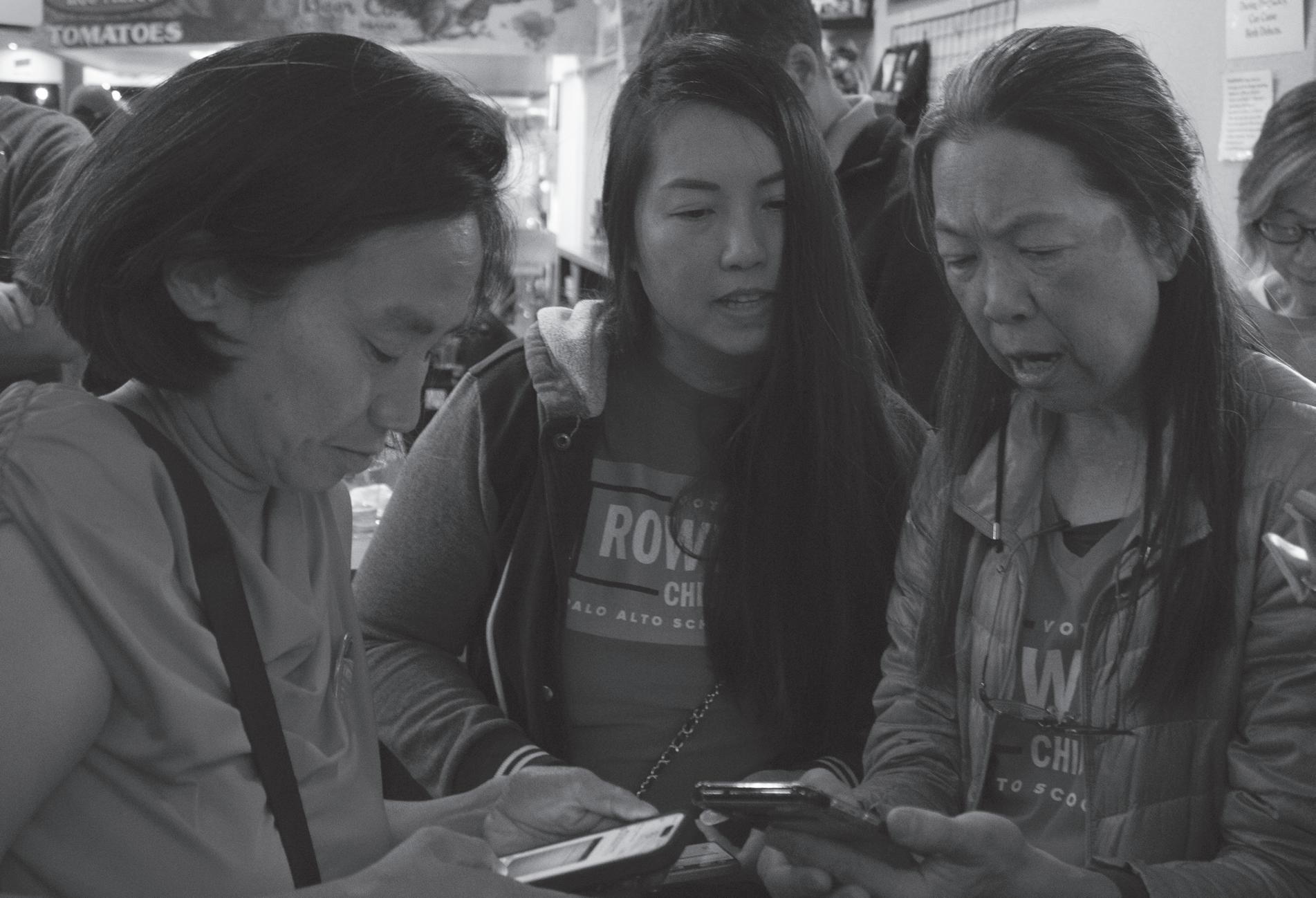

Chatter and the smell of co ee lls the air as thousands of students pour into Paly, rushing into classrooms to begin the school day.
But throughout Palo Alto — instead of the four concrete walls of the 800s building — some start their days in grand lecture halls at Foothill College, white hospital rooms and the Futures Café.
Sam Lilly, a 2024 Paly grad, spent his junior year at Lucile Packard Children’s Hospital, where he continued his coursework despite leukemia.
“ e whole reason for hospital school is because things are not going particularly smoothly, in the sense that no one wants to be there because they are sick,” Lilly said.
“Hospital, school is not something people choose, right? So it’s more like a last resort that people go to.”
“Kids who feel they don't belong or are lost in the sea of a large high school can ( nd it) intimidating even though there are incredible programs where you can nd your niche,” Chiu said. “ ere is something about a very different experience, or even a smaller experience of Middle College that I think is very important.”




In a message to the Palo Alto community on Nov. 1, Superintendent Don Austin said the novel learning environment at Middle College also allows students to escape the competitive culture of traditional high schools.



Although Lilly couldn’t attend Paly while being treated for leukemia, he was able to work independently and take assessments through the Hospital School system.
While not all PAUSD students who take additional educational pathways share the same experience, they have all found ways to further their education outside of the traditional four-year high school setting.
Newly elected school board trustee Rowena Chiu, whose daughter is a sophomore at Middle College — a partnership between PAUSD and Foothill College that allows students in grades 10-12 to earn a high school diploma and an associate’s degree simultaneously – said Palo Alto students have varied backgrounds and needs.
“ ere’s a wide diversity of students in the district,” Chiu said. “ at doesn’t just mean academically, but also, socially, culturally, economically.”
To support this wide diversity of students, the district has a number of educational pathways available including Middle College, e Hospital School and the Futures special education program.
Senior Tilman Kareht enters his calculus class. Instead of high schoolers, he’s surrounded by college students. Instead of a 30-student classroom, he learns in a lecture auditorium.
at’s because Kareht isn’t a student at Paly. He studies at Palo Alto Middle College.
Middle College students like Kareht take three high school classes: English, history and then either a math or science elective. e rest of their A-G high school requirements are taken as Foothill classes.
Middle College senior Hanu akur, who previously attended Paly, said while his initial transition from a traditional high school to Middle College was jarring, it has taught him how to navigate a new environment.
“It’s hard and scary because you’re leaving normal high school, which you’ve been part of for so long,” akur said. “ en, you’re going to college 20 minutes away. You don't always know everyone (but) I got to challenge myself in my courses and meet new people. Learning how to get to make new friends is also a skill that a lot of people forget.”
Chiu said students who struggle to nd a community within Gunn or Paly may be better suited for additional educational programs.
“ ese students picked courses they wanted to learn about and the pressure to take a class melted away,” Austin said.
Kareht agrees and said the diversity of courses o ered at Middle College allows any student to explore their passions and thrive.
“I think any student could really succeed at Middle College,” Kareht said. “One of the bene ts of Foothill is there is a super wide range of classes.”
Although Chiu’s daughter initially joined Middle College for academic reasons, Chiu said she loves Middle College for the freedom it provides.
“At the age of 15, she feels that she's being treated as a young adult,” Chiu said. “She has a lot of choice about where she’s spending time and how she's organizing her day. She really loves the autonomy and choice that she has at Middle College, and she felt that she had less of that in the larger traditional model.”
Garrison said the partnership between PAUSD and Middle College also gives students access to extensive opportunities outside of the classroom.
“I am continually impressed by our students,” Garrison said. “ ey're really trying to develop a di erent kind of culture here that is not about competition. Even though many of our students are very academically driven, our school is really about enjoying the journey.”
Scott Souter was teaching art class when one of his students came up to him and asked if he wanted to see the student’s lungs.
When Souter said yes, the student showed him a picture of them holding up their own lungs which had been removed prior to a lung transplant the student was recovering from.
at student was one of many who have been enrolled in the Lucile Packard Children’s Hospital School. Opened 100 years ago, Hospital School is available for any student hospitalized at Lucile Packard for three or more consecutive days.
“I will see students ranging from kindergarten through 12th grade, and they can come if they're up for it (and) can stay for as (long) as they want,” Souter said. “If they show up, we have a number of projects in mind.”
Teachers at Hospital School also coordinate with the student’s previous school district to ensure the student continues their education.
Lilly, the 2024 Paly grad said the program was centered around helping students continue learning in a new environment.
“ e basic idea was for you to get assigned a teacher to meet about ve hours a week (or) one hour a day to discuss coursework or questions,” Lilly said.
Lilly with this support in place he was able to keep up with his classes at Paly by working asynchronously.
“I was taking AP Lang with Ms. Launer, who sent the material to my hospital teacher, and I got the material through her,” Lilly said. “( e hospital teacher) proctored whatever tests I had to do for Paly.”
Year 2 Year 3 Year 4 Grade 9


“Our students have access to all resources, services, activities and clubs at Foothill,” Garrison said. “ ere are over 60 clubs and activities that students can be part of. It's very unique to be a part of two schools, two campuses and two worlds.”
Looking forward, Garrison said Middle College hopes to expand to ninth graders.
However, Austin said some Middle College students oppose this proposal because increasing the number of students in the program could weaken Middle College’s tight-knit community.
“Part of my hope was to expand it pretty rapidly,” Austin said. “What I heard from the students and the sta was, ‘Don't. An expansion too fast could destroy what's great about it.’”
Garrison said next year, the school will cap enrollment at 30 students per cohort, with two cohorts per grade.
Hospital School teacher Elena Melendez also said Hospital School gives students exibility. “Medications or conditions can make you feel nauseous or sick, and it's really hard to concentrate,” Melendez said. “In those cases, you're just trying to provide other services. ( e program) is very responsive to their needs.”
And Souter said the teachers at Hospital School do their best to make the environment nurturing and encouraging.
“ ey are an incredibly creative, very talented at problem solving, improvisational team that work around amazing obstacles,” Souter said. “ ey are very dedicated to providing the students or patients with continued academic enrichment or a little bit of something other than their current situation.
Dan Gallucio, a special education teacher who specializes in extensive support needs, said the Futures Program focuses on helping students in the program with functional academics like basic reading and math as well as job and daily living skills.



Futures serves students with moderate to severe needs from sixth to 12th grade at all secondary sites in the district, and its curriculum equips students with practical skills while also integrating them into the community.
“Everything we're doing in the classroom is going to be as functional and appropriate for their learning needs … we're teaching them how to take care of themselves, to achieve as much independence as possible,” Gallucio said.
ESN teacher Lisa Jauregui said the program is tailored to each student's Individualized Education Program, and through the Palo Alto Technology Collaboration Hub, students have access to iPads equipped with specialized accessibility tools, from text-to-speech to digital worksheets.
“It helps (balance) the eld,” Jauregui said. “Everybody's equal.”
Gallucio said the program also provides opportunities for students to attain real-world experience, such as running a cafe for sta on Fridays.
“We clean up the student center every day after lunch and brunch,” Gallucio said. “We deliver mail across campus. We have our cafe that we run on Fridays for the sta We also have a job on Tuesdays and ursdays where we're picking up lunch and other delivery orders from Town and Country for sta across campus.
After graduating high school, most Futures students move on to the Post-Secondary program until the semester they turn 22.
Coleman Hall, a postsecondary teacher who worked at both Paly and Gunn, said the program focuses on preparing students for adult life.
“(In high school), there's a pretty big emphasis on students going to general ed classes and joining in with their typical peers,” Hall said. “Here, it's more individualized.”
Like Futures, the Post-Secondary Post-Secondary program focuses on functional life skills through real-world experience.
“We (practice) like shopping (or) following a visual picture list to nd items in stores,” Hall said. “We do a lot of fun, exploratory outings as well, like (going) downtown.”
Hall said students also get the opportunity to spend time with Post-Secondary students from nearby cities.
“( ere are) eight di erent post secondary programs that gather once a month and have a fun social outing," Hall said.
Hall also said some students get full one-on-one support while others work on developing more independence.
“Some of those students take classes at Foothill College a few times a week,” Hall said. “A lot of them practice navigating the community independently, like going on the VTA. e ultimate goal is for them to be able to travel around town on their own, safely and independently.”
During post-secondary, students have the opportunity to join Project SEARCH, a separate program that o ers students a full-time paid internship program primarily hosted at Stanford’s Lucile Packard Children’s Hospital.
To get into the program, Lang, a Post-Secondary teacher and the head of Project SEARCH, said students must go through an application process.
“If they're motivated, they've demonstrated the drive to make it out there on their own through their work over the last couple of years, that's all we're looking for,” Lang said.
Hall said the hospital internship allows students to learn a variety of tasks with the help of job coaches.
“ e goal is for students to become independent with these job skills so that they're able to get jobs on their own after they leave the program,” Hall said.

Not all students intern at the hospital. Amy Qing, a student at Project SEARCH, worked in food service. e rst time I tried to do the food service … I didn't know how to do it,” Qing said. “I’m hoping that I will continue to build my con dence (and) challenge myself more and more."
Students who are no longer a part of Post-Secondary or Project SEARCH have the opportunity to participate in a variety of adult day programs that o er them support. ese programs o er a wide range of activities, including further education, vocational skill training, recreational activities and volunteer opportunities.
However, students who need more extensive support have limited options, Hall said.


ey've been advocating to a district that isn't willing to listen to them.”
However, Austin said the decision to move special education classes from Ohlone and Escondido to Nixon was based on a recommendation from special education teachers.
“We've called everyone who had a student in the program, and we have not had that feedback at all,” Austin said. “We called every family in the program. So (it) sounds, again, like this is a campaign issue, and that campaign (is) over, so I'd rather not talk about it anymore.” Lee disagrees. She said parents were not consulted in the decision.


$30,000
“It’s more di cult for students that need more support, one-toone support full time, (because) adult day programs operate one sta to three students,” Hall said. “It's a tough world out there for our guys that need the most support.”
One alternative, the Self-Determination Program, allows the families of people with disabilities to create their own programs by choosing which support workers to hire, how to purchase services and where their family member will live.
Hall said only about half of Post-Secondary students qualify for the day programs.
“I've had three students exit my program that are doing this Self-Determination Program, but it's really hard to get funding that way,” Hall said. “ ey basically haven't had a program since they've graduated, which is tough.”
Despite the many programs that PAUSD o ers for special education students, some community members have criticized the district’s initiatives for being ine ective and poorly funded.
Chiu said many programs in PAUSD were far from perfect, especially with the district’s large budget.
“I think as a district with a really high budget of over $30,000 per head, (they) could do a much better job of providing the resources that students need in the special needs community,” Chiu said.
Emily Lee, who has a child who was a ected by PAUSD’s decision to move special education classes from Ohlone to Nixon, said special education teachers in PAUSD are overworked.
“Our experience with teachers has been that they have been very caring, but I think they're also overwhelmed with a lot of the administrative tasks that they've been given,” Lee said. “ ey have to attend trainings. ey have to do IEP meetings and so forth. at gives them a very heavy workload, and it's something that I've de nitely noticed over the years.”
But Gallucio said he is impressed by the district’s willingness to listen to his ideas.
“I've been able to talk with administrators and build relationships with people at the district o ce who I never really had a chance to in other districts I've worked at,” Gallucio said. Chiu, though, said she is concerned about the district’s management of special education.
“What can parents and students do better?” Chiu said. “I don't know that they can do any better.

“Our case was very extreme,” Lee said. “Families that were removed from Ohlone and Escondido were told on a Zoom call, and the teachers also found out the same day, so the teachers weren't even in the loop about what news was coming down. In that speci c situation, there was, like, there was no discussion, there was no transparency.”
Newly elected school board member Josh Salcman, who is a parent of a student with special needs, also said the future of his son’s education is unknown.
“One thing that I feel as a parent is a sense of tremendous uncertainty about what things will look like for him at the middle school level and the high school level,” Salcman said.
Despite some community doubts, Gallucio said the district is moving in the right direction.
“If there were any glaring issues in the past with these programs, I think there has been a concerted e ort to really ramp up the special education services,” Gallucio said.
ousands of students enter the PAUSD secondary school system each year, each taking another step to carve their own path. rough these initiatives, PAUSD has worked to provide students of various needs and backgrounds with an education that uplifts them, whether they're in the hospital or looking to have more independence in their learning.

For example, choosing Middle College challenged Chiu’s daughter to develop her weaknesses.
“She has a 504 and executive functioning is something she struggles with,” Chiu said. “But the experience of Middle College has required her to put in more executive functioning, because she's not in the structure of the school where everyone's doing the same thing.
For Salcman these additional educational programs give opportunities to children who would not have had them otherwise.
“I'm very grateful for the fact that my son is growing up in today's world and not the world I grew up in,” Salcman said. “As a society and as an educational system, we've made tons of progress, and I think what's important is that we keep looking for ways to improve.”

WElise Andrade Sta Writer
hen I rst walked into Escondido as a kindergartener participating in the dual-immersion program, the teacher greeted me — as I expected — but in Spanish.
Despite speaking mainly English at home, I began to feel comfortable using Spanish with regularity in everyday life after just a few months of practice. Of course, it was a 5-year-old’s second language, and therefore far from perfect, but I could hold a conversation pretty darn well in this new language.
A year later, I transferred to Ohlone, joining the English program. Over the years, my Spanish pro ciency slowly declined without the regular exposure I had previously bene ted from. Still, when it came time to enter language classes in middle school, I had a solid foundation. I quickly picked Spanish back up and have since continued learning and improving my uency.
at’s the cool thing about learning a new language when you’re young: developing brains can pick up multiple languages at a remarkably fast pace. It can feel like wielding a newfound power that open up doors to new worlds, experiences, and relationships.
I now volunteer at Project READ in Redwood City every week, where I tutor low-income kids in reading and writing. In Redwood City, hear ing Spanish is almost as common as hearing English. About 16% of the city’s residents are primarily Spanish speaking. When I’m working with people who are much more comfortable speaking Spanish, it’s so rewarding to meet them where they they are, by speaking with them in their native language. Overwhelmingly, I’ve found that even if my Spanish isn’t always perfect, people are happy to nd that they can express themselves clearly and comfortably with me, and are grateful that I am doing my best to try to understand and connect with them.
e district’s language immersion programs are an incredible op portunity for students to gain uency in another language. kindergarten: in Spanish at Escondido and in Mandarin at Ohlone. As a participant in the program, your education is entirely in that language through 5th grade. e goal is to help students reach bilingual and the programs have proven to be wildly successful. A study of the program by Stanford researchers found that when compared with high school students taking AP Mandarin on stan dardized tests, the fth grader immersion kids scored the same or above the high schoolers.
However, these immersion programs only reach a small portion of students in the district— only two classes per grade cluster at Ohlone, and two classes per grade level at Escondido, have access to the program. Otherwise, the earliest students can start a language is in seventh grade.
While people are capable of acquiring a new language quickly until age 18, learning one after the age of 10 makes it nearly impossible to gain native-level words, it’s much more challenging for a 12-year old seventh grader to pick up a new language than it would be for a kinder gartener. As students get into high school, a heavy focus on meeting graduation requirements and taking challenging STEM classes emerges, language classes are often the st to be dropped. Learning another language earlier in life would allow students to clear up space in their schedules and spend more time explor ing other areas that they’re passionate about. If languages were included earlier, students could start high school in more advanced language classes, and really focus on their pro throughout high school, or even consider learning a third language. But when required language classes become extra
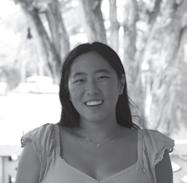
tasks to check o on top of already crammed schedules, I can understand how it becomes frustrating. By the time you get to high school, most students’ schedules are completely lled up with school, extracurriculars, and other commitments. It’s not the ideal conditions in which to learn a new language, which takes time, patience, immersion, and consistency to reach mastery. When you’re only doing it for a graduation requirement, or when you don’t have a solid foundation yet, it can feel hard to stay motivated, which I think is a big part of why some kids only complete the bare minimum in order to graduate. However, when it’s built into your daily life from a young age, learning a new language becomes automatic as you acquire words and grammar in a natural environment. If you’re immersed in it in an authentic way, it is rewarding, and if you build the skills at a young age, you will be able to further challenge yourself in a second language once you get to high school. My daily interactions with the students and families from Project READ and my ability to communicate with people when I am in communities where Spanish is the predominant langauge spoken reminds me how thankful I am that I put all of that hard work into my Spanish classes. You learn a language to be able to connect with people who are di erent from you, and learning it in a natural environment allows you to enjoy it more
which is a stark contrast to the 20% of Americans who are bilingual. Maybe you’ve heard the joke: what do you call someone who speaks 3 languages? (Trilingual). What do you call someone who speaks two languages? (Bilingual.) What do you call someone who speaks one language? (American). In Europe, according to the Pew Research Center, where there are much higher levels of bilingualism, almost every country requires kids as young as six to learn a foreign language, and 73% of elementary school students learn a second language in the classroom.
Given the rich cultural and ethnic diversity that exists in the US, language learning is especially important because it fosters multicultural connections. In order to facilitate life-long language mastery, which opens up opportunities and lends its hand to helping students form cross-cultural connections, the district should implement a more widespread path to early language uency. By helping kids get a head start on learning languages from a young age, they will be more likely to continue to pursue learning that language at higher levels. If you invest time and energy in learning something as a young child—when mistakes and failures aren’t tracked and recorded the way they are on transcripts in high school—you will value the skill more, enjoy it more, and it won’t turn into simply another task to check o your list.

why should someone who is aiming for a higher grade in the class be stuck with someone who doesn’t care?
As I open my computer at 10 p.m., I realize that nobody in my physics lab group has contributed to the project.
To make it even more frustrating, my groupmates spent the entire class period gossiping about others in the class and discussing weekend plans while completely ignoring the assignment. Now, I’m left with hours of work and the night has just begun.
is is not an isolated incident. I often seem to end up in a group where the other members slack o , so when labs are worth 40% of your grade in most STEM classes, one bad lab grade can shave points o of your GPA.
To make matters worse, when grading, most teachers only see the nal output of the group. Hardly any teachers assess individual e ort or check the document history to ensure all group members contributed equally. As a result, the students who didn’t contribute to the assignment receive the same grade as the ones who were working late into the night, frantically trying to get everything done as midnight approached.
To ensure the grading system for projects is more fair and accurate, teachers should use peer feedback forms after group projects to help ensure students will actively participate and contribute in labs and other group work. is can easily be a simple rating scale on a Google Form. ese forms are quick to make and can be reused across a year or di erent classes.
With this feedback, teachers can create groups based on compatibility, collaboration and buy-in from everyone. With more hands-on collaboration, everyone will learn more. And, after all,
Collaboration is an essential part of a workplace, and feedback forms will not undermine the importance of working together; rather, they allow for a clearer communication and understanding among group members.
Just like in the real world, poor collaboration during labs can lead to missed deadlines and failed projects. Feedback forms provide an alternative accountability mechanism to ensure students actively communicate and participate with one another.
Consistent feedback forms will also allow for a more equitable grading system. Sure, in the few cases when everyone actually tries to contribute, looking at the nal product works ne.
However, this is a rarity. In the majority of cases, some team members haven’t even written a sentence in the project. As a result, those students should receive a lower grade than the students who took responsibility for getting the project done.
Another alternative is to assign di erent parts of the project to di erent group members where every member can be graded individually for their work.
Some may argue that this system may prevent some students from being paired up with each other, but this situation is better than the alternative: when students are paired together and don’t get anything done at all, they won’t get along. e bene ts of these feedback forms far outweigh any downsides.
Feedback forms allow the classroom to succeed as a whole, causing smoother group projects and a more productive environment.
Everyone deserves recognition for their hard work and dedication — not just the luck of being assigned to the right group.
e district could model a language-learning program after the music program, which begins in elementary school, yet still allows students to have some agency in the process. If language learning were incorporated into school –- even for just thirty minutes a day — students would see ts, and it would start them on a trajectory toward language uency. Students could work with speci c language teachers, and have a degree of choice about which languages they want to learn. Although there would probably be a need to have fewer options (limiting them to Spanish, Mandarin, and French might be a good set of language o erings to begin with, due to the popularity of those languages in high school), if students wanted to transition to other languages in middle or high school, that option would still be there. Once you have a foundation in a language, it’s much easier to stay motivated to continue learning it, and even if you decide to switch to a erent language later in your life, learning one language makes learning other languages muche It may take time out of the normal school day, but its returns are worth the investment. e New American Economy reported that the demand for bilingual workers doubled between 2010 and 2015, and these numbers will keep growing. Research has shown that individuals uent in multiple languages have up to thirty- ve percent greater job prospects because they are better equipped to bridge cultural divides and communicate e ectively. Bilingual employees earn, on average, between 5 - 20% more than their monolingual counterparts. It is the responsibility of the district to prepare its students to be both understanding and successful citizens in our increasingly interconnected and globalized world, and in this day and age, that involves helping students master multiple languages.
Regular exposure to a second language from a young age, even if it isn’t the only language a child hears, would make it easier for students to reach higher levels of bilingual uency, avoid burnout, and enjoy the process of learning languages. In the end, schools have an opportunity to inspire, equip, and empower young people to grow into adults who value communication as a powerful tool to build bridges between cultures and communities.
I remember my rst encounter with books as a child — how my wide eyes drank in the sight of the ivory paper. I remember the nightly ritual of bedtime stories and the anticipation that stirred in my heart as I eagerly scanned the jet-black ink printed across the thick pages. Mysterious princes, talking dragons, magical schools — these concepts seemed so much more thrilling to my younger self than the revolving door of popular tropes in Young Adult books today.
But now, strolling through the young adult section of Barnes & Nobles, every cover and description seems to blur together: “enemies-to-lovers,” “chosen-one,” “morally gray character with a dark past.” As I disinterestedly ip through the pages of one book, I start to wonder if the adventure in books has become a giant game of “can-you- nd-the-trope.”
Tropi cation refers to a marketing practice that relies on common tropes or clichés to categorize books and make them more appealing to the target audience. Authors can advertise their books using token tropes like “enemiesto-lovers” and “dark academia” to draw in and appeal to groups of readers with speci c tastes. With the exponential growth of online book communities like “BookTok” on TikTok and “Bookstagram” on Instagram, this tropi cation, especially in the fantasy genre, has become a prominent trend. Many bookstores, including Barnes & Nobles, have adopted new marketing strategies inspired by these popular platforms, such as curating recommendations for their customers by grouping books that incorporate similar tropes.
To clarify, having popular tropes in books is not inherently bad — sometimes, I even welcome them. When my brain is overloaded with schoolwork and the chaos of reality, I prefer reading a straightforward book where I know what type of plot and characters I’m getting — it’s comforting in a sense, when the real world is lled with unknowns.
A “good” book doesn’t need to be de ned by intricate, worldbuilding, complex mysteries or clever red herrings. ere’s no shame in having a simplistic plot, and I think it’s great that the online book community has grown so large that you can easily nd a book that checks o all your boxes with a quick Google search.
However, since the recent surge in book reading after the pandemic, I’ve noticed that many new releases don’t make me feel the same way books in the past did.
With BookTok’s growing population and the rise in popularity of books like “A Court of orns and Roses,” “Fourth Wing,”
“Red Queen,” “Powerless” and the “Twisted” series, many authors have caught on to what hooks readers: a feisty and headstrong but also somehow easily manipulated female protagonist and a tan, dark-haired racially ambiguous (but still white) male love interest with a tragic past and brooding personality, but who changes “just for her.”
While popular cliché tropes can entice readers and grow an audience, centering the entire plot around them makes the story predictable and shallow. It feels like the author is using the trope as a crutch to carry their story. ere’s a di erence between incorporating tropes in a book and allowing them to drive the plot.
Popular, classic storylines don’t have to be synonymous with at, repetitive characters and predictable twists.
When a book is de ned solely by clichés and token phrases, it essentially becomes a watereddown version of the successful books that came before it. e intrigue, mystery and unique connection to the characters vanish because they are all born from the same cookie-cutter mold as countless other books — just with di erent names and slightly altered settings.
It also feels as though BookTok has an unreasonable bias against any male leads that don’t t the “dark, broody, shadowy man who would kill for his woman” aesthetic.
While some may argue that this is BookTok promoting diversity, it often just cherry-picks the “likable” or “trendy” traits associated with people of color, rather than embracing genuine diversity — especially when the authors hadn’t intended characters to be a racial minority. And if there are any characters of color, they’re often sidelined, serving as plot points to further the white main character’s journey than as central gures in their own right.
Most famous works of literature have taken inspiration from previous works, but the tropifying of books only seems to reuse trends, rather than contributing anything unique.
While drawing inspiration from previously successful books can be a good thing, I encourage authors and writers to also push beyond the clichés and write the books that keep us guessing, feeling and falling in love with the unexpected while also broadening our taste in good genres.
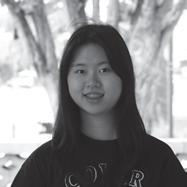
As I ride home from soccer practice in my teammate’s car, the music fades into silence as my mind xates on the stack of homework waiting on my desk. Taking my rst break in 10 hours, the city lights blur past as a wave of exhaustion washes over me. I brace myself for the daunting task ahead, feeling the weight of both dread and fatigue settle in.
Ever since I was 4, soccer has been a main inlet of my happiness, a place where I can let go of social and academic pressures.
However, it seems recently sports have started to come with its own set of challenges — overbearing pressures from coaches and colleges, performance anxiety and the fear of failure. As a result, ever since I entered high school, I started to contemplate whether I wanted to continue the sport that brought me so much joy for such a long time.
e stress that comes with playing sports is nationwide, with a 2023 American Academy of Pediatrics report saying about 70% of kids drop out of organized sports by age 13. In addition, according to the National Library of Medicine, 60% of all high school athletes experience a moderate to extreme level of stress because of their sport, and a quarter report stress negatively a ects their performance. To put it simply, as self-imposed pressures start becoming more apparent, kids stop wanting to play sports for fun.
Student-athletes often internalize stress because of a desire for validation and fear of failure. Student athletes face constant pressure to perform well, but mostly from themselves. As they navigate their athletic pursuits, they often nd themselves in a cycle of perfectionism, where anything less than exceptional feels like a personal defeat.
Many external factors also play into a student-athlete’s pressure to perform. With coaches always watching, athletes are expected to constantly be perfect. And as parents push for competitive success, coaches impose rigorous training schedules and performance expectations.
As student-athletes progress through high school, they also face increasingly challenging coursework, while college consid-

erations become more pressing. ey are also expected to maintain somewhat good grades. e NCAA requires a minimum 2.3
GPA for all Division I programs, and a 2.2
GPA for all Division II.
While Division III programs do not have speci c GPA requirements, they tend to be smaller schools more focused on academics, expecting solid grades throughout high school. For some students, recruitment
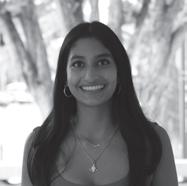
What if you had to wake up to a 6:30 alarm and make a 7:50 a.m. bell for zero period PE, followed by a full day of four, 90-minute lectures, sports practice or rehearsal after school and the tail end of production for journalism class or debate practice? ough it seems ridiculous, this is a far too common experience among students.
Although some might argue students in ict this chaos on themselves by taking on multiple extracurricular activities and rigorous classes, it has become part of the school culture. PAUSD’s existing class schedule only exacerbates the stresses of exhausted students.
Under California law, high school students are required to spend 180 instructional days and 1080 hours in school every year. is breaks down to six hours per day on average, excluding lunch. Unfortunately state law is awed when it comes to educational requirements and only creates more student stress. ere is no federal law regarding the hours per year that a high school student must attend school requirements vary greatly. According to Pew Research Center, state requirements range from 720 hours in Arizona to 1260 hours in Texas. If the number of hours were actually crucial wouldn’t they be more strictly regulated? Having a standard, scientically proven and regulated hours would reduce stress for students.
e current schedule is awed for several reasons.
First, 90-minute periods are too long. Ontario Tech University reported that most high school classes across the nation are an hour long, and even college lectures have become shorter. According to the National Library of Medicine, teenage attention spans are as brief as 15 minutes. As a result, many students tend to zone out, get fatigued or stop focusing after about an hour at maximum.
On the other hand, Monday’s short 45, and even 35, minute classes are often too fast-paced for students to keep up. In my experience, teachers tend to cram in material on Mondays that can go over students’ heads without proper explanation or time for understanding. And having to switch through all seven subjects in one
may be the only way they can attend a college — their academic future is based on whether or not they get an email from that one coach or a full-ride scholarship to their dream school.
Furthermore, if student athletes want to play their sport at an Ivy or other top level school, they must maintain strong grades in accelerated courses. e stakes are incredibly high; with their future on their shoul-
day can be exhausting, confusing, and di cult to retain anything teachers say. e worst part about the schedule, though, seems to be that its potential bene ts are not being used.
When the current 90-minute classes replaced Paly’s previous one-hour classes in 2013, proponents argued the additional 30 minutes per class would be allocated for homework completion. Parents said students were receiving too much homework, so the schedule proposal aimed to minimize, if not eliminate, homework for all classes.
And homework is not supposed to be due on Mondays to prevent students from having to cram in seven assignments on Sunday night. Quizzes, tests and other summative assignments are also not supposed to be administered that day. While some classes follow this rule, many teachers seem to have forgotten or disregarded this guideline.
So even if changing the current schedule isn’t possible, administrators should enforce the original guidelines prohibiting homework deadlines on Monday and providing more time to complete homework during block periods. is would at least make the block schedule classes more manageable for students.
As it stands, a surprising number of teachers spend the entire 90 minutes lecturing while also assigning additional homework. e district has repeatedly administered surveys during PRIME in an e ort to gather student feedback about the schedule, but no visible changes have been made in response. Additionally, all classes should provide a seven to 10 minute break halfway through all periods for students to mentally regroup. Students who need breaks are reluctant to take them since they are afraid to miss class material. is is especially crucial with the new attendance system since only two students are allowed out of class at a time. However, if breaks were mandatory and built into class time, students would be able to focus better and not have to worry about missing class. Also, there is no need for Monday to include all seven classes — the state requires three hours per week of instruction for a class to be considered a course, which the block schedule already provides. Instead, Monday’s could include four primes and an extended lunch. is would also be more useful than the current setup for students who need to check in with multiple
ders, the weight of these ambitions create extreme amounts of stress.
Measuring perfection through comparison with peers and teammates can amplify this constant, inescapable feeling of anxiety. When you are in an intensely competitive environment, with everyone driven to achieve top results, it is overwhelming — especially as a high schooler still navigating important, confusing parts of life. In these
instances, it is crucial to remember the love for the game. Otherwise, you could end up losing sight of why you started playing.
So why do high schoolers choose to play sports if it creates so much anxiety and confusion? For me, it is because of my love for soccer and the joy I feel while playing — I can let go of distractions and focus on the game, all while improving who I am and my work ethic on and o the eld.
Outside organizations can also play a huge part in helping student-athletes and their stress and motivation. Many athletes are unaware of mental health facilities available to them or feel discouraged due to stigmas surrounding mental health. Schools and sports clubs should provide ready access to mental health resources and professionals, to minimize this pressure to perform. Only then can student-athletes rediscover their love for the sport, and often perform better in turn.
Students themselves can play a huge role in this process too. eir need for perfection or fear of failure represent the unrealistic expectations they put on themselves. It’s nearly impossible for someone to have a perfect game every weekend or make zero mistakes at practice. By gaining awareness through reaching out to sports psychologists or researching methods of reducing stress, student-athletes can regain their con dence and enjoyment for the sport. Ultimately, the emotional burden of recruitment, scholarship pursuits or the pressure to perform can limit personal growth and the joy of sports, leaving students to grapple with their self-esteem and mental well-being. While student-athletes often place pressure on themselves, it’s essential to stay connected to one’s initial love for the game to sustain motivation and ful llment. So, the next time you are feeling overwhelmed while driving home from a long day of school and sports, remember to take a step back and just breathe — you’ve got this.
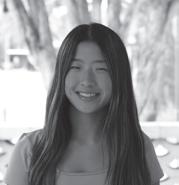
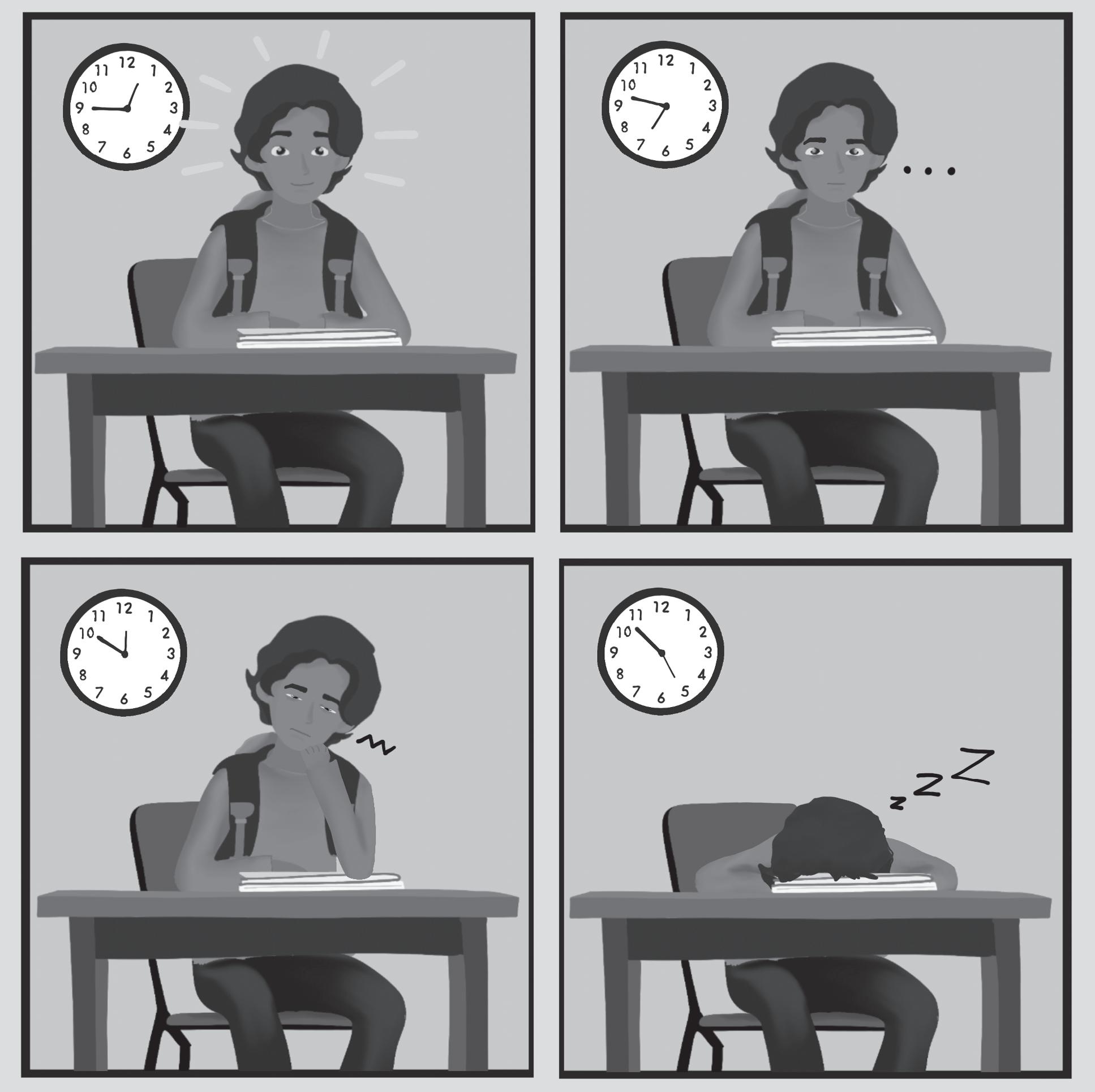
or classes regarding
Signed by Gov. Gavin Newsom in September, California Assembly Bill 1780 bars private California colleges from considering legacy and donor preferences in admission decisions. e bill will go into e ect beginning with the high school class of 2026.
With Newsom’s signature, California joins Colorado, Maryland, Virginia and Illinois in banning legacy admissions at private universities. Proponents of the bill, including the sponsor, Assemblymember Phil Ting, say it will level the playing eld for those without legacy ties to highly selective, private institutions.
e Campanile applauds the bill’s intent to create more equal opportunities for all students. A study by John N. Friedman, an economist at Brown University, found that legacy applicants are 27% more likely to be accepted at schools where they hold legacy status than at similarly selective schools. We think schools should not grant students advantages based on family background but should instead prioritize merit in admissions.
In addition, according to the American Enterprise Institute, connections with donors at private universities such as Harvard can raise an applicant’s chance of admission by a factor of nine. As a result, we think the bill’s elimination of donor preferences makes the college admission process fairer for all.
For higher education to truly value diversity, legacy preferences nationwide should be reevaluated. According to Harvard’s admissions data released during the 2014 Supreme Court case Students for Fair Admissions v. Harvard, legacy admitted students who made up 14.7% of Harvard’s student body were nearly 70% white — far out of line with the 33% of white students that made up the overall student body.
e Campanile thinks by considering legacy preferences in admissions, colleges disproportionately favor wealthy, white students, creating less diverse campus environments and decreasing opportunities for rst-generation and minority applicants. AB 1780 is a step in the right direction toward a more equitable system.

We also think California’s initiative can accelerate the movement to level the playing eld nationwide. However, while e Campanile supports the state’s intent to create more equal opportunities, we think the bill is ine ective in incentivizing colleges to comply. Private colleges, under the Association of Independent California Colleges and Universities, exerted immense pressure against the state legislature to keep legacy admissions. In Ting’s original draft of AB 1780, colleges would have been nancially penalized for violating the ban; however, private lobbying eliminated that requirement. Under the new law, there are fewer consequences for violations of the policy. e current penalties include allowing the state attorney general to pursue legal action against colleges that breach it and increasing reported data on legacy admits. Without stronger consequences for colleges that violate the new law, some institutions may try to circumvent the new rules entirely.
e bill’s original enforcement mechanism — preventing colleges from receiving state funding through the Cal Grant nancial aid program — would have been far more e ective. Still, although AB 1780 lacks stringent enforcement mechanisms to disincentivize colleges from considering legacy and donor preferences, it is a step in the right direction for achieving an admissions system that is not only fairer but could also chart the way for other states to make the admissions process more equitable.
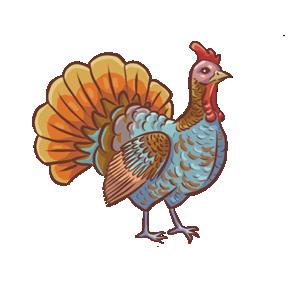









With unanimous approval from the Palo Alto City Council, the Palo Alto Link will extend its transportation service through June 2025. Launched in March 2023, the rideshare program, operated by Nomad Transportation, currently provides $3.50 rides within Palo Alto — discounted to $1 for youth, seniors, disabled and low-income community members. However, starting in December, all fares will increase to $4 with no discounted rates. Since the initial $2 million Santa Clara Valley Transportation Authority grant that funded the program expired in October, the city acquired a $1.2 million deal with Nomad Transportation and other external funding totaling over $1 million. However, the service is too costly to continue inde nitely, so e Campaniles believes the city should consider replacing Link with a shuttle. To maintain and potentially expand Link into the future, some council members have talked about having the city work with Tesla and use its Cybercab, a driverless vehicle. At an investor conference, Tesla CEO Elon Musk said the vehicles will “probably” be in production before 2027. But as of Oct. 4, according to the National Highway Tra c Safety Administration, Tesla has not yet applied for a permit or been given federal exemptions — required for vehicles without a steering wheel and pedals. Currently, Waymo makes one of the most publicly available self-driving taxis. While Tesla may be further ahead in the process than when Waymo started testing in 2009, it took nearly 10 years for Waymo to receive clearance from California to transport passengers in a driverless vehicle.
So not only will the Cybercab not be an option for Link’s 2025 contract renewal, but it is also unlikely it will be available in the years directly after. While e Campanile supports working with Tesla to increase travel e ciency, decrease costs and support climate goals once the Cybercab gains regulatory approval, we do not think a scalable partnership will be probable in the next few years. However, public transportation is crucial for many Palo Alto residents. According to a Palo Alto O ce of Transportation survey of 265 Link riders, 46% do not have access to a personal vehicle, so it is necessary for the city to prepare a plan for public transportation after 2025 in case Cybercabs are unavailable and Link is unable to receive required funding from grants. If Palo Alto cannot guarantee future funding for Link, e Campanile advises the city to invest in a shuttle service instead. Starting in 1999, the city funded a free shuttle service, but it closed down in 2020 due to nancial concerns intensi ed by the COVID-19 pandemic. When it received the VTA grant, city ofcials replaced the shuttle with Link, a temporarily cheaper alternative. However, once the grant expires and Palo Alto has to start funding Link
independently, the rideshare service would cost the city more than a free shuttle service.
Currently, Link operates from 7 a.m. to 7 p.m. on weekdays, and according to a March report by the Palo Alto O ce of Transportation, the projected 12-month cost until June 2025 is $2.3 million, ignoring outside grants. Alternatively, a 2017 study of the previous shuttle service estimated annual costs for three routes through Palo Alto at the same schedule as Link to be around $1.8 million — though costs may be slightly greater now. In the last year of the free shuttle service, the costs were around $10 per trip compared to $24 per Link ride with the $4 fare. Pricing the shuttle at around or less than Link’s original $1 fare would be cheaper for both the city and riders — even providing a free shuttle service would be less costly for the city than providing $4 Link rides. Furthermore, the shuttle service would be more e ective in serving the Palo Alto community. Due to high demand, Link no longer provides rides to and from middle and high schools during start and dismissal times. However, out of the Crosstown, Embarcadero and South Palo Alto shuttle routes, both the Embarcadero
and South Palo Alto routes would be able to carry students to and from school, decreasing tra c. is would also encourage students to limit driving to school, which increased from 2016 to 2021 — likely caused by the lack of shuttle service, according to the city — supporting the city’s Safe Routes to School initiative.
In addition to helping students get to school, the shuttle service would be e ective in assisting the broader community. With 10 cars already costing over $2 million per year, Link does not have as much nancial leeway compared to the shuttle. Link completed over 50,000 rides in the rst year. Meanwhile, the free shuttle — with only two routes — served 140,000 riders per year, saving money while also assisting a wider population. With scheduled times and consistent availability, the shuttle would provide more reliability for community members, especially seniors and those with disabilities.
For public transportation, especially for a service that costs millions of dollars per year, we think Palo Alto should prioritize serving those without the ability to drive and consider the long-term costs of Link. With a free or $1 shuttle, all community members would be able to a ord and utilize the service without limiting others’ access. While we encourage the city to invest in innovation and provide new technology to better our community, e Campanile also values ensuring a consistent, easily available service that supports those in need without placing a signi cant nancial burden on the community, which, in the next few years, we believe is not possible through the current Link program.
Letters to the Editors: Email all letters to editors to palycampanile@gmail.com. e Campanile prints letters on a space-available basis. We reserve the right to edit submissions. e Campanile only prints signed letters. Advertisements: Advertisements with e Campanile are printed with signed contracts. For more information regarding advertisements or sponsors in e Campanile and their size options and prices, please contact e Campanile Business Manager by email at ic32560@pausd.us.

elodies, rhythm and emotion ow through sophomore Jesse Spain as he writes out measures of music — notes, chords and scales play in his head, forming his own symphony.
At just 6 years old, Jesse embarked on his musical journey, following in his brother Zachary’s footsteps.
“My mom signed me up for a class at the Community School of Music and Arts, so I started playing music,” Jesse said. “ e teacher, Christina, would play the trumpet. My brother started playing trumpet, learning from her, and then I did whatever he did, so I started playing
“(Jesse) would make these songs, and we still have them written down, and then Christina said he should do piano because trumpet is not a great instrument for composing,” Zachary said. “When he gets home he’ll go to the piano and then you can hear it through the whole house because of where it sits. Sometimes he’ll record on his phone, and then maybe he’ll write it down later, because he does a lot of writing assignments.”
Often playing and composing three hours a day, Zachary said Jesse has developed a unique way of thinking about composition.
“He has a vision for how it sounds, but I don’t think you can see it from the computer,” Zachary said. “You can’t see the notes. But he does.”
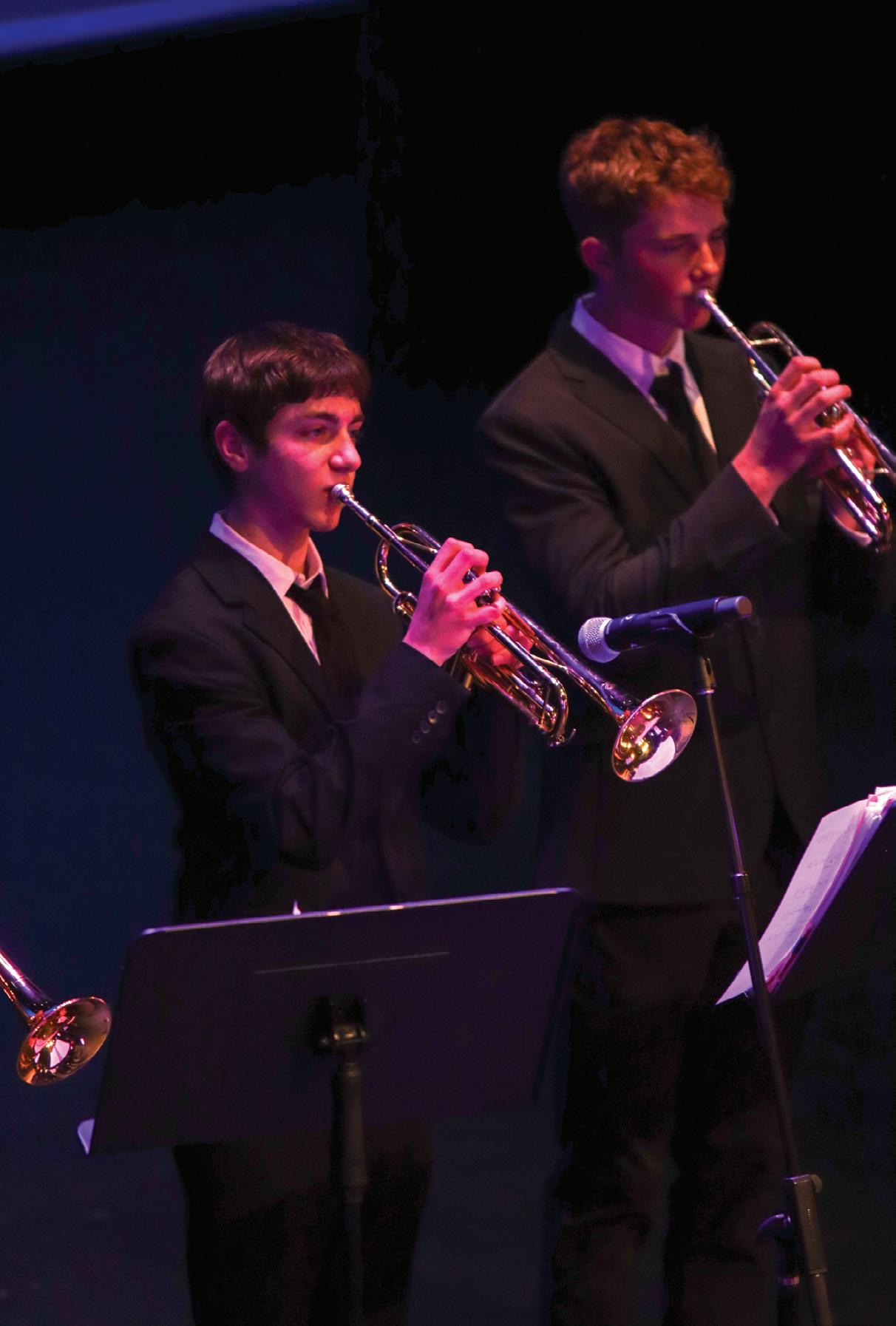
Eventually Jesse began experimenting with other instruments, and he now plays the trumpet, oboe and piano, performing in Paly’s band, the San Francisco Conservatory of Music and the San Francisco Symphony Youth Orchestra. With lots of free time during the pandemic, Jesse composed many pieces, some of which have been performed in a quartet or jazz band.
“I’ve written a lot of pieces, (but) I’ve probably only written a handful of pieces that I am actually proud of, most of which I wrote after I began to learn traditional harmony.” Jesse said. “I try to give them names with more personality than ‘Sonata No. 1’ or something like that. e pieces I wrote last year were named ‘Mélange,’ ‘Elefante’ and ‘Baguette Tails.’”
In these pieces, Jesse said his style veers away from modern music which sometimes lacks harmony.
“Composing has become much more formulaic than it once was,” Jesse said. “Everyone is using too much dissonance and trying to develop their voice, and they have lost sight of what they were trying to accomplish in the rst place.
You have to make your pieces authentic and unique without falling into the strange world of modern music.”
His taste in music and early interest in composing came from teacher Christina. He also said his SFCM teacher has further helped develop his compositional skills.
“(Christina) is still my teacher now, and we would do some composition things like turning poems into songs,” Jesse said. “Last year, I joined the conservatory where we compose music. I’ll have assignments like, ‘Write a piece for this instrumentation’. And sometimes I’ll hear a melody, or I’ll play on the piano and come up with a melody. My (SFCM) composition teacher helps me with transitions and thinking about the piece as a whole, rather than just a melody with an accompaniment.”
Jesse not only draws inspiration from his mentors but also from the composers he plays.
“When we’re playing in orchestra, Tchaikovsky or Mahler were my main inspirations,” Jesse said.
From the view of a composer, Jesse said he hopes more people come to appreciate classical music for the emotion it’s able to convey.
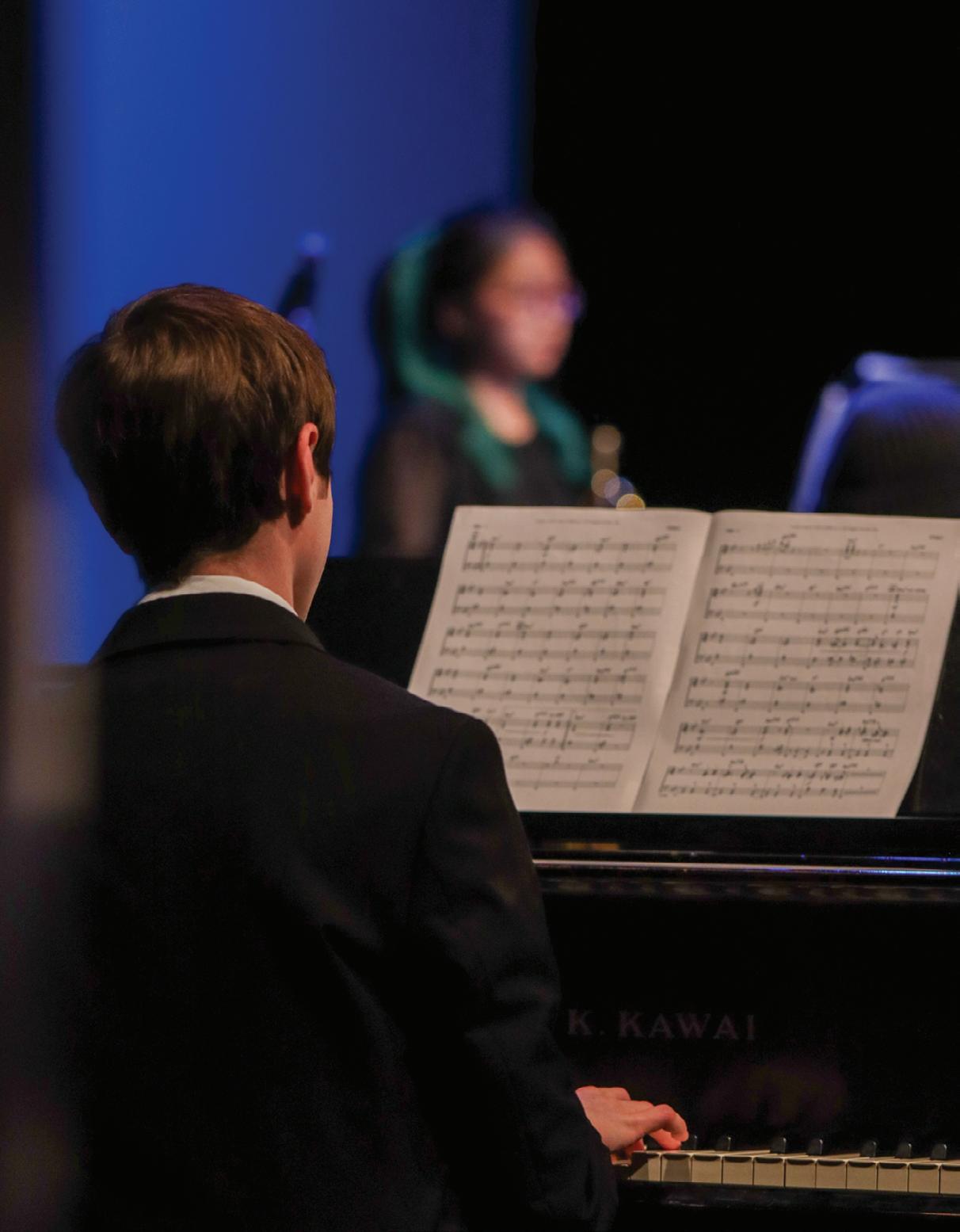
“Classical music is underappreciated because it doesn’t really have lyrics most of the time,” Jesse said. “It’s not very relatable, but it’s more about feeling — the development of a melody. It’s not for everyone, and I think a lot of people think it’s boring. You just have to listen more closely.”
As Jesse continues to compose pieces and share his work, he hopes more will be able to perform his pieces.
“ e jazz band played my piece last year, so that was one of the rst pieces they had performed,” Jesse said. “Last year, I had a few pieces performed in a quartet. And I (also) have a piece in my backpack that I’m hoping to get performed.”

Lorena de Anda sips co ee in her cozy Palo Alto apartment while she prepares for another day with her patients. As a pediatric nurse at My Friends Pediatric Day Healthcare Center, De Anda spends her day o ering medicare, helping families by improving the well-being of medically fragile children.
De Anda graduated from Paly in 2010, and looking back on her time at the school, she said she prioritized her social well-being in an academically rigorous environment.
“ ere was a lot of pressure to be really academically successful,” De Anda said. “ e academics kind of came second (behind) socializing, but I still did well.”
De Anda said she never thought academics should de ne the high school experience and because of this, she said her plan was not to go to an expensive, private college, which helped ease her stress.
“It wasn’t a big stress in my day-to-day because I kind of had a plan for myself after high school, and community college was the plan,” De Anda said. “So I didn’t really stress so much about being the best or the top of my class.”
In addition to the competitive culture, De Anda also said cliques have been creating social rifts at Paly for a long time.
“It was like the haves and the have nots,” De Anda said. “It (was) a division between the wealthy students and the less wealthy students.” is division caused many problems in De Anda’s life. Growing up in a low income household in Palo Alto, she said the city often felt intimidating, like a place where she didn’t quite belong.
“It was like this level that I was never going to reach, and I kind of internalized that,” De Anda said. “It took me going through college and pushing myself to get out of that mentality.” De Anda said seeing the di erence between her family’s nancial situation and others at Paly made her feel uncertain when it eventually came to choosing healthcare as a career.
“I felt like I wasn’t really smart enough to go into it, and I didn’t learn how to study until I got to college,” De Anda said. “I had to prove to myself that I was smart enough to do it.”
In addition, it took her a long time to choose healthcare as a career path. De Anda said she was initially a psychology major in college.
“About a year and a half in, I was like, screw it,” De Anda said. “I need to do nursing. I can do it.”
However, the road to becoming a nurse wasn’t easy. De Anda said
she discovered along the way that many who had succeeded in the eld often had prior connections to smooth out the path.
“ ey have parents that are doctors; they have family members that are in health care that can help them get into those positions,” De Anda said. “All my family is low-income. ey don’t have good jobs, so I didn’t have that help to get my foot in the door.”
Not only did she lack outside guidance, De Anda also said her nancial situation made paying for school di cult.
“After I graduated from UC Santa Cruz, I took a three year gap where I just saved money to pay for nursing school, so I feel like that kind of also put me behind,” De Anda said. “Most people were going straight into nursing school after high school and four year programs, and I had to do my four year program, take a couple years o to work, and then get into nursing school.”
However, De Anda was still able to nd resources that supported her including getting into a prehealth sorority.
We kind of helped keep each other accountable,” De Anda said. “ at community encouraged me and pushed me to keep going.”
De Anda said if she had the opportunity to redo high school, she wouldn’t change anything.
“I liked my high school experience,” De Anda said. “I know that’s not true for a lot of people, but I liked my experience, and I like where my life is now.”
And De Anda said her story highlights many valuable lessons. She said one of them is that high schoolers shouldn’t measure themselves by other people’s expectations.
“I think there’s a lot of pressure to do well (at Paly) because there’s so many expectations from parents, from teachers and from society,” De Anda said. “But I think if you just focus on what you want to do and how you’re going to achieve your goals, you’ll be less stressed.”
At the end of the day, De Anda said having a fun high school experience should be a priority of students.
“Have a social life,” De Anda said. “Have a good time. Because if you’re just studying all day, your life is gonna be really boring.”
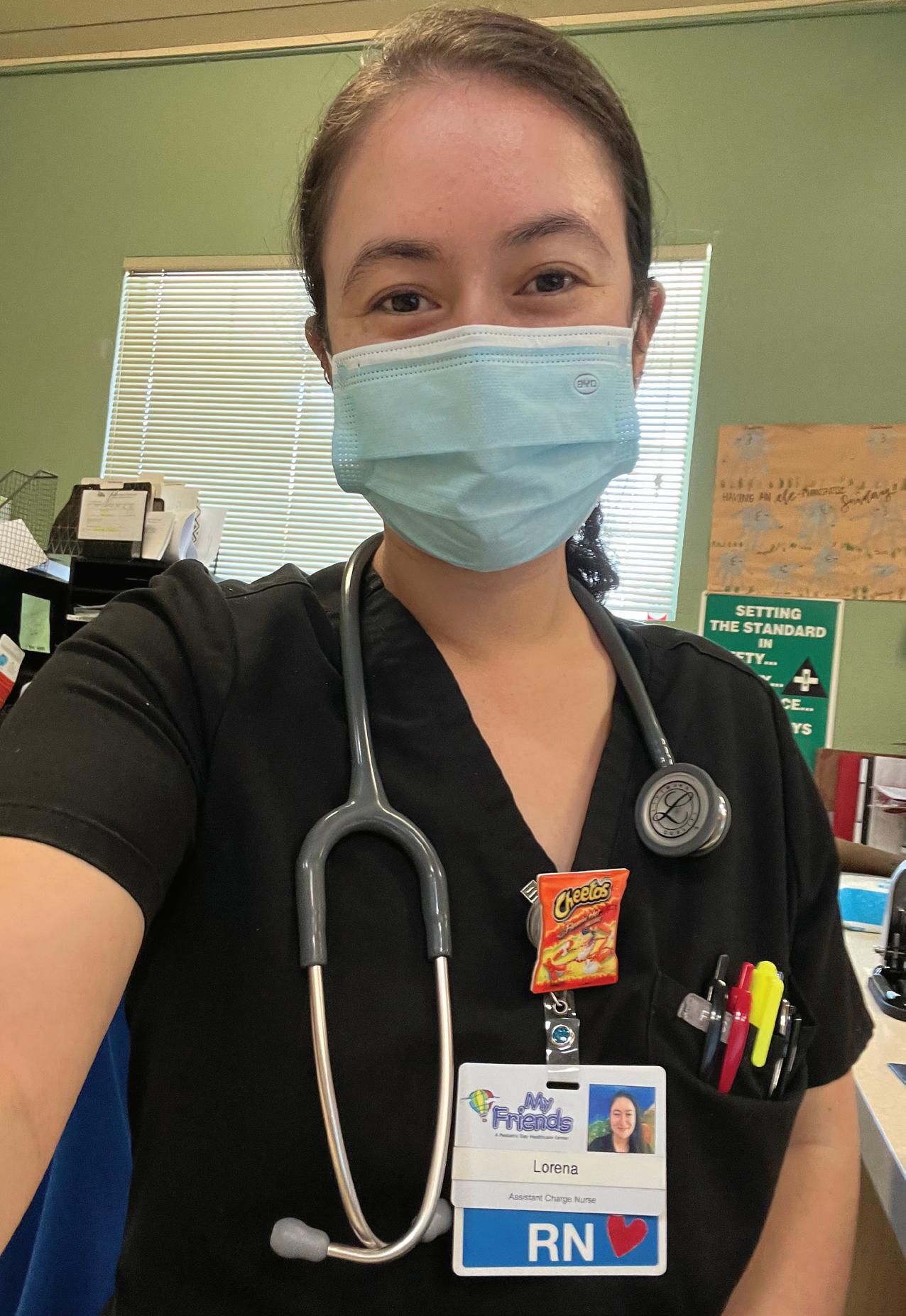
On a quiet Saturday morning, junior Jerry Yan sits in his favorite corner at the Mitchell Park Library, surrounded by open notes and textbooks, his laptop open to his Discrete Mathematics course from Foothill College. For the course, Yan takes his time on the weekend to review weekly lectures and notes and to prepare for assessments.
Yan, who started taking o -campus courses with a Multivariable Calculus class during his sophomore year, said he was forced to take out-of-school classes because PAUSD doesn’t o er accelerated math lanes.
“It’s extremely hard for high school students to get into the courses we want,” Yan said. “It takes a long time to get the enrollment processed, (so it) was mostly independent (for me). Paly could help by giving clear direction for students in accelerated math (lanes).”
In addition to o -campus accelerated math courses, a program called Scout from University of California, or UC Scout, is popular among students. UC Scout says it is a nonpro t organization o ering high-quality A-G, and AP courses and curricula for educationally disadvantaged students. It currently o ers 67 courses.
UC Scout Outreach Specialist Adra Bowman said the program helps students access courses not available at their schools and learn at their own pace.
“Everything is self-paced at UC Scout. It’s high quality, engaging and interactive,” Bowman said. “Our primary mission is to increase access to A-G and AP courses in California, (although) we serve students out of state and internationally (as well).”
While UC Scout classes are online, Bowman said all of the teachers are trained by UC Scout’s professional development series.
“All of our instructors are credentialed in California and have previous experience teaching
in-person, and we have both full-time and part-time instructors that work for UC Scout.”
UC Scout o ers three plans for high school students: Basic, Plus and On-Demand, priced at $29, $49, and $399, respectively. According to the UC Scout website, the Basic plan is typically priced at $29 per student per semester, but it is free for California public school students. e Plus plan functions as a teacherled option with live instruction. Finally, the On-Demand plan is the only plan that o ers a transcript and credit for completing the course.
Bowman said the On-Demand plan is the most popular.
“Our On-Demand plan is what a lot of students are already familiar with. at’s where we provide independent study courses,” Bowman said. “So we’re o ering the
teacher and the credit, and it’s just all housed within our program. (When) high school students attend, they get to decide if they’re going to accept that UC sta credit on the high school transcript.”
Junior Ari Seeger, who took an AP Physics 1 OnDemand course from UC Scout his sophomore year, said the program was a great way to maneuver around strict lanes.
“UC Scout allowed me to take Chemistry Honors at Paly while simultaneously taking AP Physics 1 o -campus, which is an alternative to Physics Honors,” Seeger said.
Seeger, who is now taking AP Physics C, said he also appreciated the exibility of UC Scout and how it fostered self-paced learning.
“ e self-paced learning made it easy to t within my already busy school schedule,” Seeger
said. “If I wasn’t able to nish tasks during the weekdays, I could always make it up during the weekends.”
College Advisor Sandra Cernobori said taking ocampus courses through programs like UC Scout is not only a way to advance academically but also an alternative to ful lling graduation requirements.
“For students who need to ful ll eligibility requirements for college, it is a way that they can take those classes if they can’t go to summer school,” Cernobori said.
However, Cernobori said the On-Demand plan at UC Scout is expensive and students may not be able to a ord it, creating an unfair dynamic.
“UC Scout is actually quite costly, so then I think it becomes more of an equity issue,” Cernobori said. “ e cheapest way to do that would be to go to a community college.”

Acknowledging these challenges, Bowman said because a goal of UC Scout is to make education accessible to all students, they have put in e orts to o er nancial support to students who can’t a ord the On-Demand fee.
“ e cost can be reasonable, depending on what you’re comparing it to,” Bowman said. “We also have a scholarship program (that) is available for a single course per term. It takes the cost (of On-Demand courses) from $399 to around $50.”
According to Bowman, her UC Scout is also constantly developing new courses including AP Microeconomics and Personal Finance.
“We partner with hundreds of schools throughout California,” Bowman said. “We have some new courses that are already underway, and we anticipate we’ll continue growing as a lot of more students learn about us.”
Despite his successful experience with UC Scout, Seeger said he would like PAUSD to make o -campus course options clearer.”
“I was lucky to nd out about UC Scout through my parents’ connections, but I do wish Paly made it easier for students to know that there are other options available,” Seeger said. “Students should be able to choose ways to learn, and schools should be supportive of that.”
Editor

Isabelle Carlsen Business Manager
Paul Samson, a 10-year-old barber entrepreneur, ushers a friend outside to a chair in his backyard next to a pair of scissors and a spray bottle. He wets his friend’s hair and begins gently combing it before delicately snipping the edges. en, he picks up his razor, tapering the back of his friend’s hair with quick, upward icks along the neckline. At last, the highly coveted taper fade is nished.
While the fade may be the most recent trend for men’s haircuts, the look has gone back decades, slightly evolving based on the latest fad. Similarly, for women, hairstyles have seen notable evolution since the 1920s from short to long and from natural to dyed.
According to Brendan Liberati, a celebrity hairstylist, hairstyles often become popular for various reasons including technological advances in styling tools and products, celebrities, and fashion trends. In addition, the evolution of hair also stems in part from social change and our nation’s political climate.
“When society feels more stable or conservative, there’s often less pressure for fashion and hairstyles to push boundaries or make bold statements,” Liberati told e Campanile. “We tend to see more experimental and rebellious styles during periods of upheaval or change, as people use their appearance to express individuality or dissent.”
Hair has even changed the way men and women are portrayed in society. During the Roaring Twenties, bob cuts were in, replacing the Gibson Girl look of upswept, voluminous hair. is time period de ned this idea of “ e New Woman,” symbolizing the liberation era for women by dispelling the notion that women need to always be in perfectly manicured attire.
Similar to the post-World War I era in the ‘20s, the ‘60s counterculture movement had women opting for shorter, more masculine cuts while men began growing their hair longs. Palo Alto resident Wilma Cardwell said compared to the ‘20s, women wore both more feminine updos and hats in the ‘60s.
“In the ‘20s they wore little hats close to their face and the hair was kind of short,” Cardwell said. “ en the ‘60s was the beehive. eir hair was teased, and it was plucked on top of the head and a little bit behind the top of the head.” en came the ‘80s and big-statement hairstyles: mullets, side ponytails, Jheri Curls, and punk looks. Samson said to him, the ‘80s represented a interesting time of fun and self-discovery.
“I have watched many ‘80s-themed shows and have seen the wildly styled, gigantic and teased hair many women had and the crazy mullets and greasy hair men had,” Samson said. “ ese looks seem like they allow for each individual to nd their own style regardless of what others might think, which I believe to be really freeing.”
In the after-e ect of the 2000-2010s, pop artists like Britney Spears in uenced sleek- at ironed hairstyles, chunky highlights, and choppy cuts. Additionally, Samson said, balayage hair, which gives hair a sun-kissed look, became a trend in the 2010s and has carried through to 2024.
“Growing up in the 2010s, I remember the women talking about getting a balayage done and watching videos online with women who had ombre hair,” Samson said. “Even now, I see girls my age wanting it done, which I believe testi es to how much past hairstyles continue to in uence us.”
Today, social media has blazed the way for in uencers to create hairstyle trends. is, according to Samson, will de ne the future thanks to their inclusivity of views increasing throughout the internet.
“Social media has (the) hairstyling tutorials and product reviews needed to encourage people to explore various styles and nd what’s best for them,” Samson said. “ rough hair and what it represents, we have made so much progress and growth since the 1900s. I believe we will continue to grow thanks to our open-mindedness of haircuts and styles providing individuals the opportunity for self-discovery and understanding what role their hair plays in forming their identity.”

Over the course of American history, anksgiving festivities have evolved to be as diverse as the country itself, uniting a vast background of traditions, dishes and cultures into a singular day of gratitude.
From Chinese food to traditional roast turkey and mashed potatoes, families’ anksgiving traditions often re ect their unique cultural heritages.
Senior Kinga Czajkowska said while her family doesn’t directly celebrate anksgiving, they use the occasion as an opportunity to gather with loved ones.
“My culture doesn’t exactly do anksgiving traditions because it’s a very American thing, and my parents aren’t from America, but every culture has a tradition of being together for ( anksgiving),” Czajkowska said.
Czajkowska said her main holiday meal is di erent from traditional American food, as her family opts for a meal of Polish chicken instead of turkey.
“I hope to pass on to my future family that chicken is a better ( anksgiving meal) than turkey,” Czajkowska said.
Junior William Xue said his family meets for a meal and has a custom of saying a anksgiving salutation in Chinese.
“We always connect with our friends and family, give thanks to
Stylus in hand, senior Vit Do leans over her iPad, swiftly navigating through her taskbar and array of Biology diagrams.
With a practiced ease, she makes colorful annotations on each nucleotide, enjoying the bene ts of both digital tools and handwritten notes.
For Do, this method has become second nature, having grown up alongside piles of stationery and bullet journals. Later at home, Do moves from learning to reviewing her material, shifting her notes onto her computer.
Do said she alternates her method of note-taking depending on whether she is learning or reviewing content.
“If I am learning the information for the rst time, I write it down instead of typing it,” Do said. “However, if I’m reviewing a concept, I just type out concepts to remember them.”
Senior Divya Gandhi, who also
With increasing iPad use, Gandhi, who uses the app GoodNotes, encourages students to search for a note-taking app that is best suited for their use case to maximize bene ts.
“Make sure you know how to use everything because in a lot of these apps, there are a bunch of useful tools that aren’t obvious to people,” Gandhi said. “On an app that I use, there is a button that records audio. So if your teacher talks really fast, you can just hit record and listen to it later and slow it down to take notes.”
Based on his research, Carnegie Mellon University Professor of Psychology Danny Oppenheimer said handwriting notes, either on
for memorization if I handwrite, there’s too much information,” Juyal said. “(Handwritten notes) are a lot more time-consuming whereas with digital typing, it’s a generally faster process. I also have to make note cards for tournaments, so it’s a lot more convenient to do it digitally.”
Since there is a variation in notetaking needs, Oppenheimer said notetaking is a case-to-case situation.
“If your goal is to have as complete a record of what was said as possible, then you should type notes as you’ll be able to type more quickly and take down more of the lecture,” Oppenheimer said. “If your goal is to take e ective notes on things that don’t lend themselves to typing, you should handwrite.”

Regardless of others’ preferences, Do said she prefers using an iPad for note-taking because it allows for more exibility compared to notebooks.
“With iPads, when I want to rewrite a little detail, I can adjust it, move it ecting the visual spread,” Do said. “When I had to carry a backpack around with (paper) notes and binders, I felt a lot of it on my back. On an iPad, you can’t run out of paper, so I can have 50 page notebooks if I need.”
Do also said using free iPad PDFs is
“For AP Lit, I have to read a lot, and I personally prefer downloading the PDF that my teacher provides and then annotating it there,” Do said. “I don’t have to spend $20 on buying a book just
Looking forward, Oppenheimer said he expects the evolution of note-taking to follow the development of AI.
“It’s possible that students will soon have the ability to capture verbatim records of class without taking notes at all,” Oppenheimer said. “Hopefully that will push students toward the sorts of reasoning and note-taking that is most ective — thinking deeply about material and jotting down their thoughts.
Of course, it’s also possible that autotranscription devices will allow some students to tune out entirely, letting devices take notes for them while they
Heather Song Managing Editor
each other and enjoy some great anksgiving food, and we’ll say ‘gan en jie kuai le’ (“Happy anksgiving” in Chinese),” Xue said.
Junior Chloe Chan said her family’s decision to celebrate anksgiving with Chinese food allows her to connect with her culture and relatives.
“We eat hot pot. e base is usually tomato and soy sauce and the inside are vegetables, sh cake and meat dumplings,” Chan said.
For junior Suzie Mondragon, whose family enjoys a conventional turkey meal on anksgiving, it’s not the food that makes anksgiving special but the routine her family follows.
“I remember when I was little, we would walk around Stanford campus, and my dad would bring a skateboard, and we would have my dog with us and just skateboard and walk around,” Mondragon said.
Mondragon said her family also puts up eccentric decorations every year.
“We have a fake stu ed turkey that has a little electronic gobble sound that we will always put out,” Mondragon said.
Xue said spending time and laughing with his family are his fondest memories of anksgiving throughout the years.
“One time we were cooking the turkey in the oven and watching the turkey through the oven’s glass,
and we thought everything looked ne, but then 10 minutes later, the turkey turned black and we were so shocked,” Xue said. Besides celebrating, Czajkowska said her family likes to use anksgiving break as a time to clean and reset for the upcoming winter. ere is an obsessive amount of cleaning — literally everything — including places that my family won’t even visit,” Czajkowska said.
“Everybody gets involved in it somehow because not one person cooks, and we all have to do something.”
As anksgiving approaches, Mondragon said it is a custom for her family to send out greeting cards and a family photo.
“I’ll get my hair done, and we’ll get dressed up (for photos),” Mondragon said. Xue said his cultural customs hold a special meaning to him, enriched by cultural traditions that he hopes to carry on for generations.
“Something I hope to pass on to my future family and traditions is that I hope we’ll always think about each other,” Xue said. “Always be grateful for each other and appreciate what every member of the family does, what all of our friends do.”
Amaya Bharadwaj Sta Writer

Paly eatre’s fall production of “Our Town” premiered at the Performing Arts Center on Nov. 15.
Set in early 20th-century New Hampshire, the three-act play followed George Gibbs (senior Ellis Edmonds), Emily Webb (junior Aashi Agarwal) and their families in the small town of Grover’s Corners as they navigated themes of family, love and mortality.
Director and theater teacher Sarah ermond said she chose to perform “Our Town” as a more intimate play that contrasted with the dramatic spectacle of “Hamlet” performed as last semester’s spring play.
“I thought that would be a cool acting challenge after doing such high energy shows last year,” ermond said. “(‘Our Town’) is also a real classic play; people have even called it the greatest American play.”
Sophomore omas Pitman said one of the biggest challenges in preparing for the show was balancing theater with other commitments. As the play’s assistant director, Pitman held many responsibilities including publicity, note taking and directing.
“Scheduling con icts are always di cult,” Pitman said. “I’ve put in over 100 hours (on the play).” Despite the hard work and long hours, junior Brendan Giang, who played Dr.
Gibbs, said he enjoyed exploring how each character’s complexities added depth to the play.
“(Dr. Gibbs was) another middle-aged man with a PhD,” Giang said. “He (was) not the central character in the story, but he (played) an important role in showing the di erences between the relationships in the show.” ermond said one distinctive characteristic of the play was that it broke the fourth wall, the imaginary barrier between actors and the audience.
“It involved the audience a lot,” ermond said. “ ere were characters who spoke directly to the audience and acknowledged that it was a play.” Ultimately, Giang said the performance aimed to resonate beyond the stage. eater is about a community of people coming together to create an experience, a meaningful experience for audience members,” Giang said. “Our goal is not only to entertain but also for them to leave with something maybe they hadn’t thought of before.”
Lucas Yuan Editor-in-Chief
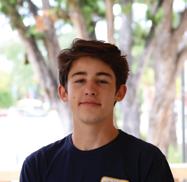
Thanksgiving is the best time of year, and it’s the only time I can truly disconnect from outside worries. Over a mix of conversation, good food and soft music, aromas of roast turkey, cranberries and pumpkin spice waft through the air, and my family shares our latest happenings and favorite memories at the dinner table.
After over a decade of anksgivings with my cousins and friends, we celebrate the same recipes, games and quality time together. Since I was a little kid, these have been our family’s favorite traditions, and I want to share my favorite memories and the best recipes we’ve curated throughout the years.
Aunt Mignon’s stu ng
My Aunt Mignon sparked my passion for cooking. Since I was little, she ensured anksgiving was my favorite holiday. She always put me to work in the kitchen, making me taste her food experiments while simultaneously working as a 6-year-old sous-chef. One of the most memorable dishes of hers for me — that has now become tradition — is her stu ng, with sausage, turkey, apple, breadcrumbs, onion and chestnuts. I have fond memories of quartering the chestnuts while trying to sneak bites of the thyme and rosemary italian sausage. e breadcrumbs soak up the seasonings and stock, while the celery and onions
provide a subtle sweet crunch. My aunt never fails to make perfect stu ng.
Although Aunt Mignon improvises the recipe without measurements, I would recommend using Melissa Clark’s Brioche Chestnut Stu ng to best replicate my aunt’s magnum opus.
Monkey bread
Soft, buttery, salty and doughy in taste but not in texture, savory monkey bread is the pinnacle of my family’s meal.

After our rendition of Julia Child’s great brioche bread would always come out underbaked, my uncle Micheal tried a di erent technique. Using the same recipe, he baked it like monkey bread in a bundt pan. Voila! Best bread ever. Smaller dough pieces rolled in butter and dill create a buttery smell that lls the air and a u y, yeasty taste dominates the plate. It’s mouthwatering and irrefutably one of the best dishes ever made with the only downside being how hard it is to stop eating it.

vegetarian dishes. Surprisingly, my dad came up with these delicious garlic parmesan brussel sprouts which are golden brown, crispy, garlicky and a perfect balance to a rich meal.
Infuse three tablespoons of a neutral oil with a few cloves of garlic, cooking the garlic and removing them once they start to brown. Put the brussels face down over medium-high heat, and after a few minutes of cooking, cover for 10 minutes. Simply ip them when golden brown and grate some parmesan for a delicious side dish.
Micheal follows Julia Child’s brioche bread recipe until shaping, then rolls smaller dough balls. Roll them in butter and optionally dill, then stack in a bundt pan and bake as instructed.
Brussel sprouts

e next morning: Juk


Because of my mom’s poor choice to be a pescatarian, over time, my family has found many tasty
Often, the best part of our night is the postprandial that symbolizes friends and neighbors are about to come over with their distinct desserts. Over games like Codenames or charades we take small bites of apple galette, pecan and pumpkin pie, molasses spice cake with maple frosting and various chocolates, as we convinced ourselves that dinner hasn’t completely lled us up. Out of all of the desserts, my favorite is the pumpkin pie. I would recommend using either the e Joy of Cooking” recipe or Tastes Better
From Scratch recipefor pumpkin pie.

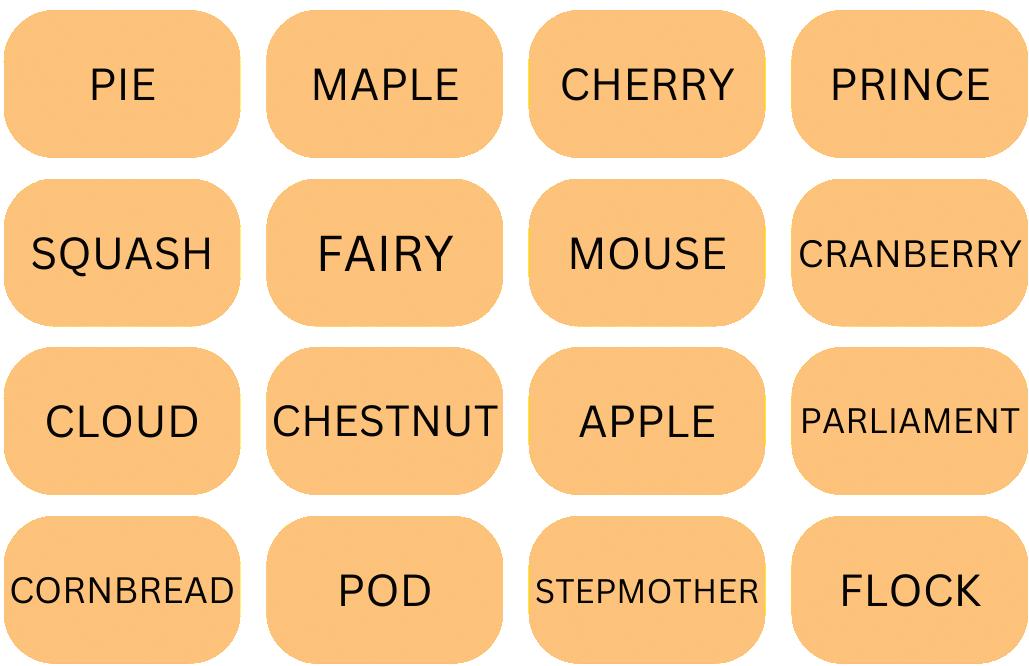
e next morning, our traditions include a morning run, playing football and basketball and going for a jump in the lake. e highlight of the morning after anksgiving is a unique but special dish: juk. Juk, also known as congee, consists of turkey or chicken, rice, garlic and green onions. Aunt Mignon uses leftover turkey to create a cozy rice porridge dish that brings back all the great memories from the week. After adding soy sauce, which gives the juk a salty umami avor, you’re left with a warm, meaty and fresh rice porridge. In a large pot, add one cup of short grain rice (like sushi rice), the leftover turkey and bones and six cups of water or enough to barely cover the turkey. Cover and let it cook at low heat for six to eight hours, stirring and adding water as needed. Serve with soy sauce and a sprinkle of green onions.

Final thoughts I hold each of these foods close to my heart every year. I sometimes think it’s funny I have all of these memories associated with our anksgiving recipes, but I’ve come to realize it’s not all about the food. e time cooking and baking brings us together and while the food enlightens our week, it’s the people we share it with that make it so special. At the end of the day, anksgiving is about one thing: gratefulness. e time spent and memories made with family is priceless, and for that, I am forever grateful.





When senior Nicolas Ogawa rst began competitive swimming at the age of 12, he didn’t immediately see himself reaching international waters and swimming under the ag of the United States. However, his recent participation as part of the US team in the 2024 World Aquatics Swimming World Cup in Incheon, South Korea, is a testament to his dedication to growth in the sport.
In Incheon, Ogawa swam the 100-meter butter y, 100-meter backstroke, 200-meter breaststroke and 200-meter individual medley.
Ogawa said one challenge he faced was racing in shortcourse meters, a format he wasn’t accustomed to.
“We usually swim in yards, not meters,” Ogawa said. “It was de nitely very di cult for me to adjust.”
Unlike high-stake competitions where qualifying times are crucial, Ogawa said
his training before the meet remained the same to help him keep consistency and focus.
“In the grand scheme of our season, how we did at this competition didn’t really matter,” Ogawa said. “We kept our training pretty regular, even though once we got to Korea, practices got a little easier to focus on what we’d be racing.”
Still, Ogawa said it felt surreal to meet some of his icons, including Olympic gold medalist Chad le Clos and NCAA champions, athletes he grew up idolizing.
“It was humbling to see such amazing athletes,” Ogawa said. “Seeing them in person, it’s crazy. Being around Olympic medalists and record holders was insane.”
Another challenge Ogawa faced was managing the pressure to perform, as he often felt intimidated by the competition.
“Everyone was so much bigger, taller and stronger than I am,” Ogawa said. “I’m
in the waiting room with these massive, six foot tall guys, slapping themselves, making all these noises, and I’m like, ‘Holy, I am not in my element.’”
Ogawa also said he even found the preparations for the event, such as undergoing cap, goggles and suit checks alongside well-seasoned athletes to be an intense process.
“For my rst race, the 100 y, I was in the ready room with two NCAA champions from Berkeley and Stanford,” he said. “I was just sitting there like, ‘Woah.’”
Paly varsity teammate and junior Romy Kirby said Ogawa’s dedication to the sport is unmatched and inspires the rest of the team.
“He is always motivating the rest of us,” Kirby said. “He has this amazing ability to bring energy and focus to each and every practice, and he never settles for anything less than his best.”
Ogawa said Incheon was also a chance for him to see how the extensive sacri ces he has made for swimming have paid o “ e entire year, my life needs to revolve around school and swimming,” Ogawa said. “Everything else needs to just fall to
the wayside. I barely hang out with my friends and family because whenever I’m not swimming, I’ll just be doing work.”
And despite his busy schedule, Ogawa said he has found ways to balance his commitments in terms of both academics and athletics.
“In a sense, instead of giving up on the things, I’ve had to nd a way to sort of t those things in my life,” Ogawa said. For Ogawa, his commitment to swimming goes beyond competition — it’s a relentless pursuit of perfection, where the tiniest adjustments can make all the di erence.
“I like swimming because I love practicing every day to try to improve,” Ogawa said. “It almost feels like an art because we can spend hours trying to improve the smallest things such as hand potion or body angle just to go hundredths of a second faster.”
In its nal league game on senior night on Nov. 8, football lost to Los Gatos 44-6.
Junior and kicker Lara Saslow said the team didn’t prioritize winning, knowing Los Gatos was one of the top teams in the league.
“We were just focused on putting in our other players that hadn’t really played yet and getting ready for playo s,” Saslow said. “It would be nice to win, but we weren’t really focused on winning. We knew that it was unlikely and that we should focus on what’s next because we’re hoping to have a long postseason.”
However, Saslow said this mindset may have hurt Paly’s performance.
“We were de nitely scared going into it and didn’t have much hope,” Saslow said. “It was just hard for us to compete, but we did show them a bit of what we have towards the end of the game, and we picked it up a little bit and were able to score.”
Head coach David DeGeronimo said several players were injured going into the game.
“It’s not an excuse, but we just have a limited number of guys, and we have a lot of young guys playing that haven’t played before; to go in and play against a top team like that is a great challenge,” DeGeronimo said. “Our goal is to improve every week. I think we’ve been kind of stuck for a little while, and that comes on to coaching … but everybody’s doing the best they can. ey’re playing hard. Guys are stepping up.”
Senior and captain Joseph Kessler said the team was distracted throughout the week, which likely contributed to its loss.
“We weren’t very focused at practice, and it’ll translate into the game,” Kessler said. “ ey’re a very good ball club over there, Los Gatos, and we’re banged up, so we came in just playing one for the seniors, and I think we had a lot of young guys step up in the big moment. ey nally got a good taste of what it’s actually like, and I’m really proud of how they performed and handled the tough challenge.” Kessler said he is also proud of the seniors’ leadership this year.

“I’ve stepped up in the place of some very big shoes,” Kessler said. “We lost a lot of guys last year, but together the senior core has done a very good job program.”
Saslow agreed and said the seniors brought both skill and energy to the team.
“A lot of them are really good players, and they helped us win, but they were also just motivating us and keeping the energy up in practice,” Saslow said.
For DeGeronimo, senior night is always a special night.
“I really enjoyed watching our guys,” DeGeronimo said. “ ese seniors really were a big part of changing the culture the last three years, and they really did a good job of getting the younger guys to buy in.”
Kessler said he has mixed emotions about his nal game of the league season.
“I spent four years of my life playing football here, and this was the last one, so I’m kind of short for words right now, but I’ve had a blast,” Kessler said. “I’m proud of the brotherhood that we’ve continued to create, form and shape. A lot of these guys I might never see again, but we’ve had a hell of a time ying together.”
11/2, W, 12-4
Paly vs. Gunn 10/17, W, 15-1
vs. Los Gatos 11/8, L, 44-6
Paly vs. Menlo 11/2, L, 27-14
vs. Castilleja 10/23, L, 24-6
Paly vs. Gunn 10/22, L, 32-31
Paly vs. Los Altos 11/2 L, 11-5
Paly vs. Los Gatos 11/2, L, 12-7
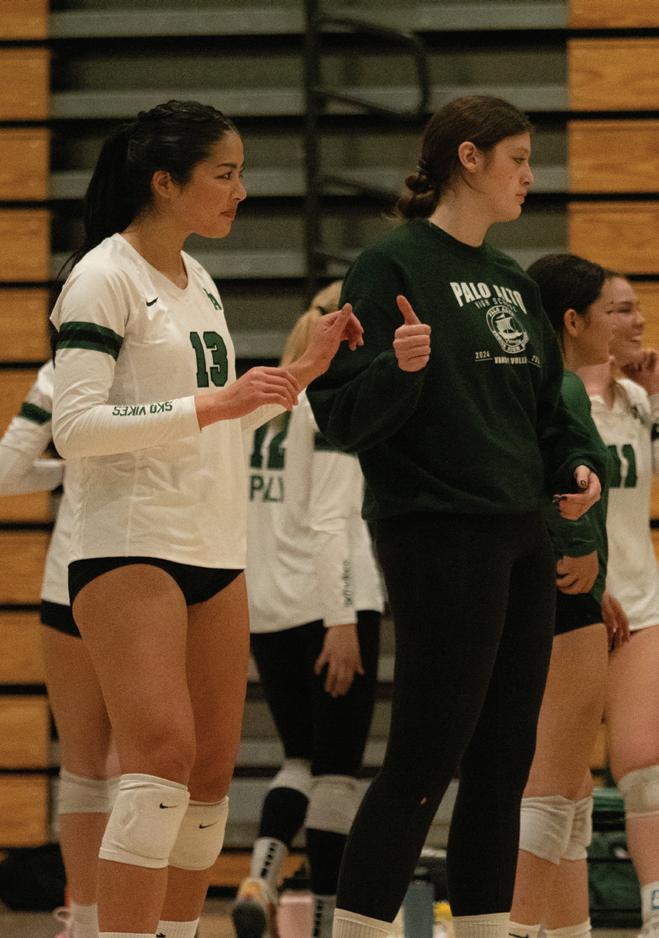
Securing a league championship, the girls volleyball team celebrated senior night on Oct. 28 with a 3-1 victory over Los Altos.
Senior and co-captain Sophie Pan said ending the season with a win felt especially meaningful after missing much of the league season with an injury.
“Our team did really well stepping up while I was gone,” Pan said. “It feels really good to end my high school career with a league championship.” Senior and co-captain Sophie Mies said having her friends and teammates at her last home game was bittersweet. ese are some of the last times that I'll ever be able to play with my best friends,” Mies said. “It’s very rare that you’re able to be together, so I’m very grateful to be a part of this team.” Coach Chris Crader said he attributes a big part of the team’s success to its tight-knit dynamic.
“ e team gets along so well,” Crader said. “You can see that by just looking around. ey all support each other, and they all trust each other.” And Crader said he knows the seniors will make an impact beyond the court.
“ eir years here are winding down, but their lives are just beginning,” Crader said. “ ey're gonna go on and do great things in volleyball and in general.”
As the excitement around the World Series cools down, the NFL season heats up with fresh faces, new storylines and dramatic predictions. Sure, we’ve seen teams like the Chiefs and Eagles dominate the past few seasons, but with the 2024-25 season upon us, expect new contenders and shake-ups in the standings. Sports Editor Rohan Bhatia and Photo Editor Rahul Shetty take a look at the playo picture at the trade deadline.
Starting with the NFC, it’s impossible for us to overlook the Detroit Lions as the one seed. It’s fair to say they surprised fans last season with a deep run into the playo s. While they’ve been a franchise known for mediocrity, the Lion’s o ense is poised to prove last season wasn’t a uke, with the second-highest points per game in the league. Jared Go is an experienced quarterback and wide receiver Amon-Ra St. Brown is terrorizing the NFC North. e defense has been picking up the slack as well, keeping a 13.8-point di erential per game, even with the loss of Aidan Hutchinson.
For the second seed, we see the NFC East’s Philadelphia Eagles as a dominant force. With Jalen Hurts continuing to develop, and a loaded roster on both sides of the ball, including a menacing defensive line, Philly will continue to challenge every team they face. With an accurate Jalen Hurts, acrobatic Saquon Barkley and a Wide Receiver core including AJ Brown and Devonta Smith, this team is capable of shredding defenses when they’re locked in. Additionally, the defense has conceded the third-fewest yards in the league with leaders like safety CJ Gardner-Johnson.
e Atlanta Falcons are our pick for the three seed in the NFC. Kirk Cousins has been bouncing around teams for years but nally established his dominance putting up 2,600 yards through nine weeks, a top-three gure in the league. With a receiving core of Darnell Mooney and Drake London, and Kyle Pitts being a top- ve receiving tight end, its o ense has strongly rebounded. Its defense may need to pick up the slack in the playo s, but it remains passable. e combination of improved o ense and solid defense, combined with the weaker AFC South will allow them to snag the third seed. In fourth, we predict the San Francisco 49ers will snag the spot. Maybe it’s just denial speaking because the Niners have been struggling, spouting a 5-4 record. However, they have also been dealing with a di cult injury crisis, and quarterback Brock Purdy proved he’s a playo -caliber quarterback because of his developed skill, not his team’s superstar o ense. Additionally, with star running back Christian McCa rey returning, we predict the o ense will hit the ground running for a strong second half of the season. And the defense is still a top 10 defense in the league, likely to be boosted by Trump-supporting Nick Bosa given the election results. is prediction is one made with reservation, because the NFC West is one of the more competitive divi-

Moving on to the Wild Card spots, it’s impossible not to give the fth seed to the Commanders. ey have been perpetually mid, so it was a surprise to see a 7-2 start to the season following longtime owner Daniel Snyder’s sale of the team to Josh Harris. But the Commanders have a newfound resolve, with Jayden Daniels throwing for 2100 yards thus far, and also being the team’s rushing leader with 464 yards. Additionally, our fantasy goat Terry McLaurin remains criminally underrated with more than 700 receiving yards to his name, the third most in the league. Paired with a passable defense, this Commanders team can rival the Eagles for the division title spot, but we think they’re going to settle into a Wild Card spot.
In the penultimate seed for the NFC, we have the Minnesota Vikings. Headlined by one of the best receivers in the league, Justin Je erson, the Vikings embody a solid team all around. Sam Darnold is having an alright year with 2100 yards, proving once again how bummy the Panthers are. Je erson is second in receiving yards, with 831 to his name, Aaron Jones is having a solid rushing season, and the defense has conceded the fewest points in the NFC.
Finally, the Green Bay Packers round out the NFC playo picture. Jordan Love has looked decent as the starting quarterback, but they’re still a young team
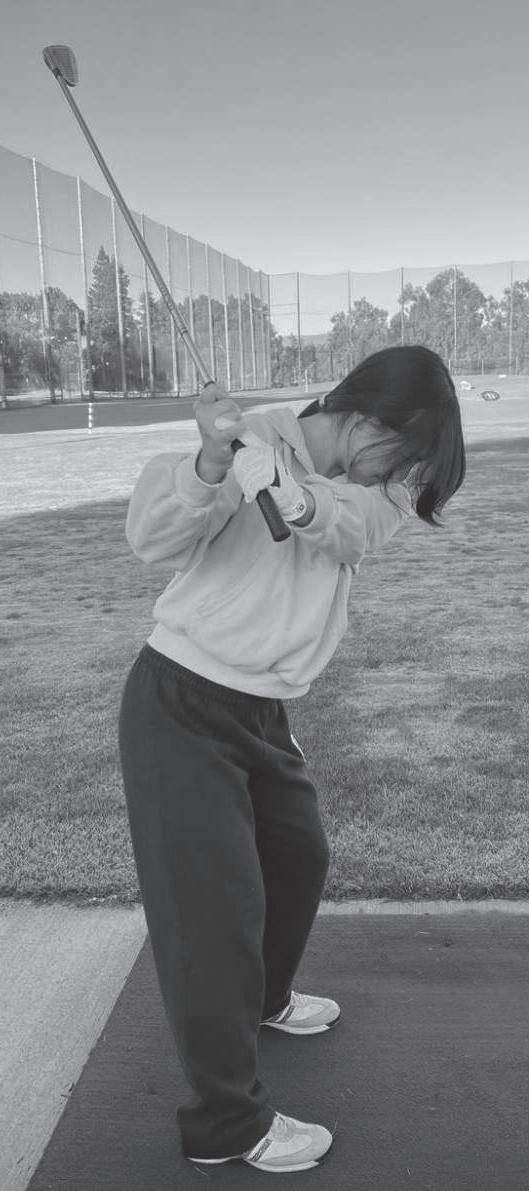
e girls golf team nished a season that head coach Doyle Knight called memorable, with a 6-4 record.
with a lot to prove. ese days, the Jets look more like the Packers than the Packers; they will continue to seek their own identity. e Packer defense is another solid one, slotting in just behind the Vikings in terms of yards conceded per game. e playmaking ability of Josh Jacobs and Jayden Reed should help them make a playo push, but they’re just a step behind the other NFC teams vying for the top spots.
In the AFC, the Kansas City Chiefs remain the class of the conference. With Patrick Mahomes at quarterback, Andy Reid at the helm, and the refs in the booth on their side, this team is always dangerous. ey remain the only undefeated team in the league at the time of writing. Age catching up with veteran talents like Travis Kelce won’t stop the Chiefs from cruising to rst place in the AFC West. We are expecting yet another deep playo run from them.
e Bu alo Bills have a lot to prove after heartbreak in the postseason, but with Josh Allen remaining a dynamic quarterback with 17 touchdowns and four interceptions, they’re set to push Kansas City for that top spot. eir defense will need to pick up the slack, but the Bills are a lock to at least compete given their record and the apathy from the rest of the AFC East.
e Baltimore Ravens are our pick for the third seed. Lamar Jackson, now in his prime and with a bolstered
“We improved a lot by score — their putting and their chipping was a lot better by the end of the season,” Knight said. “Our average strokes were getting lower and lower. ey shaved o about 30 strokes every time.”
Although the team played well, Knight he saw room for improvement in a number of areas.
“We lost some of the matches we probably should have won, but unfortunately everyone has some bad days,” Knight said. “We probably would’ve been in second or rst place in the league if we hadn’t lost two of the games we should have won, but in the end it’s golf, so it’s not like they didn’t try — they just had a bad day.”
Junior Devon Kardwell said the team’s mood had a big e ect on their ability to play well.
“If you get in a bad mindset or you have a couple bad games, sometimes it would be hard to get out of the bad mindset,” Kartwell said. “Sometimes you have a bad hole, but you just have to keep your head up and don’t let it a ect you.”
But Kartwell said the team’s tight-knit community was a helpful support system and got her through the season.
“Everyone is really close on the team, especially because of how small the teams are, so you get really close with your teammates,” Kartwell said. “It was very fun — we would get boba after if we won, and the environment was just the best.”
And Knight said he is proud of the team’s accomplishments.
“I didn’t know exactly what to expect, but the team really pulled through, and they all put a lot of time and e ort in to get better,” Knight said. “I was very impressed by their performance, and I’m excited for what next season brings.”
supporting cast like league-leading rusher Derrick Henry, will make this o ense as di cult to stop as any in the league. Zay Flowers and Rashod Bateman are another underrated receiving pair contributing to the deadliness of the o ense, which has achieved 440 yards per game, an unrivaled gure. eir primary challenge will be out-throwing and out-rushing a struggling defense, but we predict the Ravens will still secure the AFC North, despite tough competition from the Steelers.
e Texans will nab the fourth seed as the nal division leaders, redeeming football in Texas given an embarrassing Cowboys season (though the Longhorns remain the pride of Texas). e Texans are a decent team, especially with CJ Stroud at the helm. But besides Stroud, no other o ensive player has impressed. In addition, a similarly mediocre defense means the Texans grab the spot mainly out of a lack of competition from the rest of the division.
e Pittsburgh Steelers are an easy pick for the fth seed; don’t sleep on Mike Tomlin and his ability to get the most out of his squad. With Russell Wilson and Justin Fields sharing the quarterback role, a solid Najee Harris in the back eld, and George Pickens headlining a decent receiving core, the o ense is in good hands. Additionally, allowing just 2,700 yards so far, the sixth fewest in the NFL, the Steelers Defense is quite impressive. ey rival the Ravens for the top spot in the AFC North, but we predict they will comfortably settle into a Wild Card spot and a decent playo run. e Chargers will slot into the sixth spot. Other than Justin Herbert, the Chargers don’t have the deepest or most talented squad. Additionally, their stats indicate a middle-of-the-road team. Despite this, they just keep winning, with a record of 6-3 so far, they are the only team in the AFC West to show any sort of resolve against the Chiefs. Legendary head coach Jim Harbaugh is coaching this squad to an impressive record, earning a Wild Card spot for their e orts. Rounding out the AFC playo picture are the Cincinnati Bengals. Joe Burrow is still putting up incredible numbers following that Super Bowl heartbreak, leading the NFL in yards thus far. Ja’Marr Chase is another incredible wide receiver stuck in Je erson’s shadow, about to hit the 1000-yard mark; the o ense has the tools they need to succeed. ough saddled with a mid-tier defense, the Bengals are an unimpressive 4-6. Despite this, we think they can make a second-half push to secure the nal wildcard spot, just edging out Sean Payton’s Broncos for the spot.
As always, the NFL is unpredictable, and with the talent across both conferences, nothing is certain besides uncertainty –– and the Chiefs getting favorable decisions from the refs. Time will tell who will ultimately come out on top, but one thing is for sure: the 2024-25 NFL season will be one for the ages.
Rohan Bhatia & Rahul Shetty Sports Editor & Photo Editor
Four days a week, after a long day of school, junior Cara Augustine drives to her Sunnyvale gym. After a quick warmup, she sprints across the oor, jumps and ies into a sequence of cartwheels, back handsprings and ips before sticking the landing. Starting gymnastics when she was 2, Augustine has been competing since she was 7.
Still, Post said participating in sports can improve mental health by providing the opportunity to exercise and engage in a close community.
trying to achieve unhealthy expectations regarding their performance. ey fall into self-critical thinking and other traps.”
Sports specialization is de ned as intense training in a single sport for at least eight months per year. Specializing in a sport from a young age can have consequences on mental and physical health due to overexertion and the repetition of straining movements. Because of this, some researchers and health professionals recommend waiting until high school to hone in on one sport, even for people aiming for elite competition.
Over the years, Augustine said she has broken her ankle, fractured a vertebrae in her back and torn her Achilles tendon. She said burnout in gymnastics that some athletes feel is largely due to the extreme physical strength demand of the sport.
“I feel like it is a common experience for every single gymnast,” Augustine said. “Not constantly, but very often, you’re like, ‘Should I quit?’ I’m so tempted to quit. Part of it is how physically demanding it is. I want to do the sport for my whole life, like the rest of my life, but I know that, physically, I can’t handle it … ere are other points where it’s just so draining.”
Sarah Squires is a captain-coach for e Hidden Opponent, an organization that seeks to support athletes and raise awareness about athlete mental health concerns. Squires said she played soccer from the age of 5 to her second year of college, but she quit because of injuries that continue to impact her.
“I’ve had a couple knee surgeries — like an MCL surgery and PICA — and then a lot of concussions,” Squires said. “I currently have post-concussion syndrome. I still go and coach and play very lightly from time to time, but I can’t play competitively anymore.”
While there can be physical harm involved with specializing in a sport, it can also take a toll on the mental health of athletes. Lisa Post, a clinical professor of psychiatry at the Stanford Department of Medicine, said being in a high-pressure environment can create mental health issues and contribute to burnout.
“Sometimes you can have stress from trying to balance your sport and your other obligations like academics and friends because they have a pretty rigorous practice schedule with a lot of hours and travel,” Post said. “If you have a bad relationship with a coach or teammates, or if you don’t t in for some reason, there are issues there that can be problematic, and sometimes it’s hard to decide to give it up, right?”
“Exercising is good for your mental health,” Post said. “So is coming into college and having a built-in set of friends on the team. And it gives you a sense of identity, for sure.”
Augustine agrees and said while gymnastics can stress her, it has also helped improve her mental health.
“It’s what I do when I’m upset, and it’s what makes me happier,” Augustine said. “So I’d say it has a positive impact on my mental health. But in general, the set-in-stone practice times can be hard when you don’t want to go to practice, or it’s been a hard practice. If your coach is mad at the beginning of practice, you’re gonna have a rough four and a half hours.”
However, when she started soccer, Squires said the conversation around mental health was extremely limited, creating unaddressed stress, stemming from the pressure to perform, which began in sixth grade.
“As a youth, growing up, I don’t think I totally had all the outlets to deal with (anxiety),” Squires said. “I just dealt with it by doing more soccer or doing more schoolwork, whatever it was. It was not the healthiest of coping strategies, for sure.”
Post said the early push to choose an interest exacerbates anxiety for many athletes.
“Something that stresses people out is when everything just gets so focused on, ‘What am I going to do next? I have to plan out my entire life,’” Post said. “And there’s a lot of, ‘I’m not good enough,’ on social media. I think those are the kind of things that take a lot of the fun out of it.”
Sacred Heart senior Paola Reinosa didn’t start specializing in volleyball until her freshman year of high school and said the pressure she felt to perform varied throughout her volleyball career. Despite focusing on a sport later in her adolescence, she said she was still able to reach high levels of achievement.
“It’s the number one question you get if you play a sport: Where are you committing?” Reinosa said. “And that’s a really big pressure for high schoolers because they’re not really thinking about (enjoying their season). ey have to be thinking about performing well for colleges.”
Gabriela Bolivar Villalobos, a psychologist who works with elite youth, college and professional athletes, said the competitive nature of sports draws in ambitious people — people who typically struggle to prioritize their mental and physical health over performance.
“Sometimes people can be perfectionists around sports,” Villalobos said. “ ey fall into
Villalobos said research that supports waiting until later to start specializing con icts with professionals’ and athletes’ opinions.
“Most high-achieving athletes do start young,” Villalobos said. “It may just depend on the sport — gymnastics and gure skating, for example, are very technical sports. In swimming, athletes absolutely start as young as possible. But I think that in certain sports, you can get away with starting later in life. at doesn’t mean you can’t play well if you pick up a sport later. I just think if you’re talking professional level, then you need to start young.” But Reinosa’s experience goes against this. Despite not starting volleyball until her freshman year in high school, she is captain of the varsity team and has received o ers to play volleyball in college.
“I think it could have gone two ways because I’ve seen various people burn out,” Reinosa said. “I’ve seen people playing since they’re 7 years old up until right now, come a long way, and they’re dropping the sport because they don’t enjoy it anymore — whether it be like coaches or just that you’re literally doing the same thing for nine years of your life. So I understand, but if you’re really passionate about it, those are the people who move on to be successful.” e best way to support athletes, Squires said, is to have an open conversation surrounding mental health.
“(Supporting athletes) is having that open communication and being able to recognize and say, ‘Yeah, mental health is a thing, and we’re here to support you,’” Squires said. “ ese are resources you can reach out to. Coaches and people need to recognize that we’re students before athletes and humans before students.”
But in terms of overall health, Squires said it’s likely better for most young people to wait.“I think you can wait a little bit longer,” Squires said. “I hear of kids specializing like I did in elementary school, and you don’t need to. It puts too much stress on you, mentally and physically. You do have more time to improve, especially in junior high and high school. High school is a great time to get into sports and work your way up.”

Despite the stresses, Augustine said she’s grateful she started early to get a head start in gymnastics.
“It really depends on what you want,” Augustine said. “It might sound crazy, but for me, the injuries are worth it for the outcome, the teammates, the people I’ve met and how happy it’s made me. But for other people, it’s not worth it. I think starting that young was good for me because it gave me so much more time to do it. But I think it just really depends if you’re willing to take the risk of the injuries, and if you’re able to nd ways to separate yourself from your sport.”
Squires said it can be hard for many athletes to give up something that has been an instrumental part of their lives for so long.
“If you’re young and specializing, your identity gets wrapped up in sports so much, and when you lose that, it has such a detrimental e ect on mental health,” Squires said. “Your identity is so many other things, but because you know you’ve spent so much time doing that one thing, it’s hard to unwrap that from your identity.”
Girls varsity water polo falls to Leland, looks to the future
Rahul Shetty
A week after clinching rst place in the league in their win against Los Altos, the girls varsity water polo season came to an abrupt end with a 15-8 loss to Leland High School in the rst round of CCS. After winning their league for the rst time in 18 years, the 14-2 Vikings could not capitalize as the 4th seed of the Open Division of CCS.
Junior attacker Delilah Kaplinsky said the intensity shifted from the last game of the season to the rst game of playo s. “ e level of competition changed a lot, as we were going from Division I at the end of our season to open for CCS,” Kaplinsky said. “Knowing that we would be going up against all the really good private school teams and being put in an underdog situation gave us the option to either play down or step up to the challenge with more intensity and motivation than before.” Kaplinsky also said the team’s mentality during a tough stretch was instrumental in their success throughout the season and into the championship game.
“In the middle of the season, we started playing worse than expected and losing games,”
Kaplinsky said. “At this point, we all knew that it could go one of two ways. Either we could all continue the bad trend and let the season go to nothing, or pick ourselves back up and play harder and better than we had at the beginning. With this goal in mind towards the end of the season, we all agreed to hold each other accountable for our actions and show up for the team. For the following games, it was clear that we were going to go in as a team, play as one and win.”
Senior Katie Spitzer said the team prepared intensely for the game.
“ e week before CCS we did a lot of practices focused on running our defensive plays,”
Spitzer said. “ e biggest challenge was trying to anticipate what the other team would do based on the information we had about their team.” Spitzer said she encourages next year’s team to use this season as a lesson to continue their success.
“A big takeaway for me is the importance of playing as a team because as soon as that became our main focus that is when we started playing at the level that I knew we could,” Spitzer said.
“For next year’s team, they should keep up the momentum we built this season and work to go even farther in CCS.”
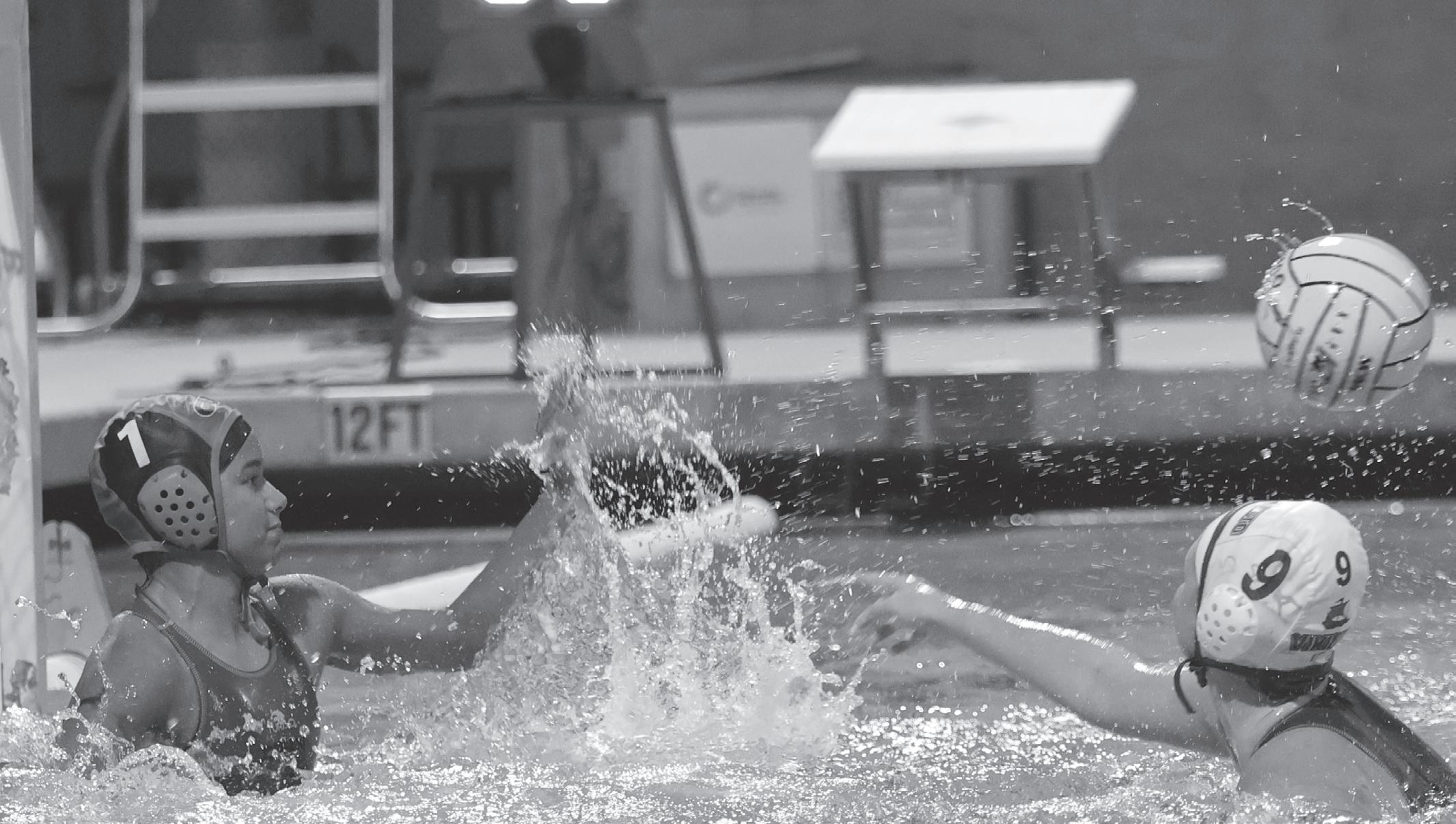

rst came to the Bay Area in 2017, he discovered virtual reality and augmented reality. Since, the technology has sparked an interest in him that has captivated him, boosted his productivity and his gaming experiMotwani, the editor-in-chief of “Veritas,” Paly’s science publication, has used VR for studying and gaming, and has owned both Meta VR goggles and the Apple Vision Pro. “I’m originally from Georgia, and I visited Palo Alto once when I was younger,” Motwani said. “ e rst time I visited, I went and tried out the Oculus Rift at Meta headquarters when it was just slowly coming into action. And then a few years ago, I bought an ere is also growth in the market as the global VR market size is expected to be above $22 billion in 2025, according to Statista. Mattia Crespi, the founder of Qbit, a Bay Area based tech startup that specializes in VR and AR, said part of this growth is due to easier access to the technology as more companies eld. e increase of attention is essentially due to the technology developments that are new,” Crespi said. “More performing headsets. More people have tried it. More software is available, especially in gaming.”
Since his discovery, Motwani said he has experimented with augmented reality in other “I’ve tried the Apple Vision Pro…” Motwani said. “I’ve also used other forms of AR on phones, like putting objects in space to understand how clothes Because of its ability to work in space, VR and AR proerent than computer gaming. But junior and avid programmer Boris Nezlobin said VR and AR are created through 3D programming, which is similar to how e way most VR and AR rendering engines work is (by) building some 3D representation of the environment,” Nezbolin said. en they add objects to it and transform that 3D representation into a two-dimensional digital display, which isn’t too di erent from Crespi said childhood movies, along with his desire to explore “It was a passion in the sense that I was fascinated by the ability of computers to create a virtual space, a vertical dimension in which you could do things,” Crespi said. “I had seen that in movies like ‘Tron,’ e Lawnmower Man’ (and) ‘ e Matrix.’”
Because of interest in VR sparked by movies or other passions, Motwani said it’s more possible than ever to enjoy content.
“Because of how many people are starting to use it, I’ve seen more games and experienced development,” Motwani said. “ e Apple
Vision Pro released an app that could let you watch F1 races on your desk. ese types of experiences wouldn’t have been possible a few years ago.”
Despite its limitations, Motwani said he has noticed more students taking an interest in VR and AR, especially because of its price, with the Meta Quest 3 being $499.99.
“A few of my friends at Paly have started getting VR headsets, and that’s mainly because of Meta,” Motwani said. “ e Meta Quest is one of the easiest ways to get in at a low cost.”
Beyond lowering cost, Motwani said recent aesthetic changes have made VR glasses more accessible.
e biggest thing we’re going to see with VR and AR, at least, like the coolest new thing, is going to be when we get our goggles into glasses,” Motwani said.
But Motwani said comfort remains a large factor in consumer hesitance.
“With any headset, and like ski goggle type design, it’s going to be uncomfortable for a while, and so until we switch to, like, a full glass of system,” Motwani said.
“Early on, when I needed the systems, or I was doing a lot of productivity, and I needed the screen real estate, I could use my VR headset to mirror my display and then make massive monitors,” Motwani said. “I can have, like ve monitors in virtual reality.”
However, before these improvements are implemented, Motwani said Meta VR glasses price must decrease to become more popular and usable.
“ e price to produce each of those pairs of glasses as per the (Chief Technology O cer) of Meta is $10,000, and the reasoning for that is that they require something called a silicon carbide lens. When you’re projecting an image onto the lens of your glasses, it has to hit it in a very separate way, so that that light can get projected back into your eyes,” Motwani said. “You can’t just project it on a lens, or else it will be distorted in a way.”
In addition to price concerns, Nezlobin said programming-wise, building AR can also be a di cult process, especially when it concerns speed.
“Getting it to run fast is pretty di cult with AR. Especially, building the three-dimensional environment is di cult to do in realtime, so it’s often xed by using like sensor,” Nezlobin said Motwani said he believes that VR has high potential.
“I really do think that in the future, once we get better systems for virtual reality and augmented reality, we’ll see those appear a lot in our daily lives,” Motwani said. “Whether it’s having a pair of glasses that can run your calendar on your side or many of the things that you do on the phone, you can do your messages on your glasses, or you can use it as your computer display, so that you don’t need to be looking or you can have multiple monitors at the same time.”
Companies are investing in AI now more than ever. In 2023, global corporate investment in Arti cial Intelligence reached $189 billion, a 1,300% increase from 2013, according to Statista.
Allison Harbin, an AI analyst and former prompt engineer for Google’s AI assistant, Gemini, said the sudden craze in AI led her to transition from working as a writer and editor to working in AI.
“When ChatGPT came out, I saw the writing on the wall, and I was like, ‘Oh my gosh, they’ve automated my job,’” Harbin said. “If you can’t beat them, join them. So I took the job at Gemini, and we were mostly former teachers and former academics. We were the humans in the loop for reinforcement learning.”
Students make up a signi cant portion of ChatGPT users, which has helped drive its growth. ChatGPT has over 200 million users as of August 2024, double its number from last fall, according to Reuters.
AI Club President and junior David Wu said he uses various AI tools to help with coding.
“Speci cally for coding, I think GitHub copilot is very helpful, as it really helps you to write the redundant code much faster,” Wu said.
As AI has become more widespread, many companies have implemented it into their services. According to a National University article, 77% of companies are using or exploring using AI. Harbin said the most exciting part about more companies investing in AI is its potential impact on the working environment.
”(AI) is like this big gray space where we’re still not really sure what large language models are capable of,” Harbin said. “You get to be a part of guring out how ChatGPT, for instance, can be used in a business, professional setting that saves money.”
Senior Sean Gustavson said many companies are increasing investments in AI due to its ability to increase productivity by automating tedious tasks and customer service.
“AI is billions and billions of dollars worth of investment,” Gustavson said. “We see large companies like Meta buying one speci c computer part to put in a very large server to run a bunch of models, which they then release for free. Since this directly bene ts the public and helps out everyone, it attracts signi cant interest and investment into their company.”
However, Harbin also said many companies investing in AI are doing so rashly without considering the logistics.
ese companies are de nitely rushing into it,” Harbin said. “ ere’s going to be a bubble, and that bubble is going to burst when people realize that we have this technology, but we don’t know how to apply it in a work use-case where this solution is going to save the company money.”
Harbin said AI chatbots, while similar, should focus more on perfecting accuracy as opposed to rushing into implementing AI into services.
“I started on Gemini, and at my current position we use OpenAI’s 4o model,” Harbin said. “I’m using them in really di erent contexts, and to a degree, they’re the same, but I think the ones that I’m interested in are the ones that are more accurate and more dependable. e way that companies invest the most wisely in terms of workforce to train those models will get better outputs.”
Gustavson said over the past few years, AI has become a highly competitive and saturated industry.
“OpenAI, for a while, has been at the forefront of AI technology,” Gustavson said. “(But) I don’t think they necessarily have a moat (anymore). From 2022 to 2023, the moat OpenAI had was the billions to train these models: they had the leg up in funding cash. Now, as every big company from Google to Meta is pouring money into their AI research projects, it’s becoming a more level plane. We see new competitors like Anthropic outpace OpenAI’s top models in everyday tasks, and they’ve only been around for a few years.”
